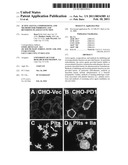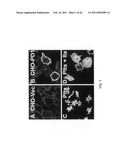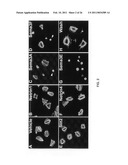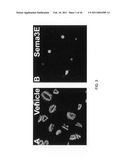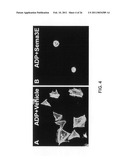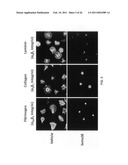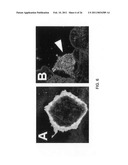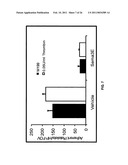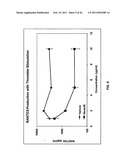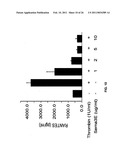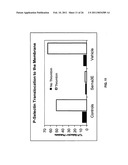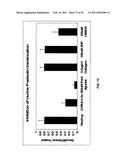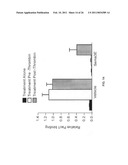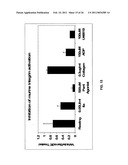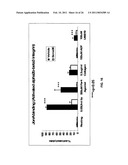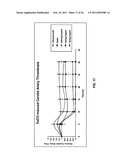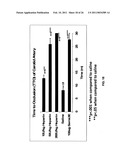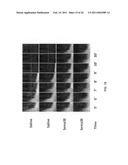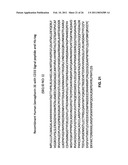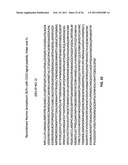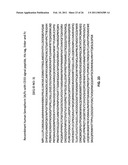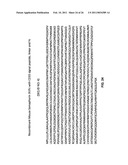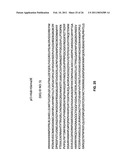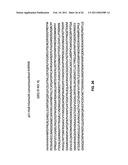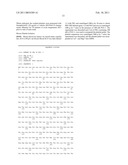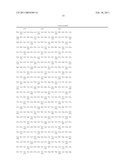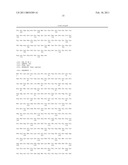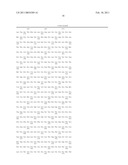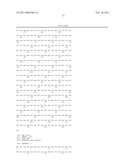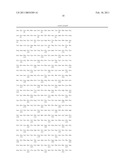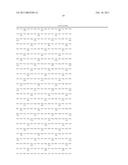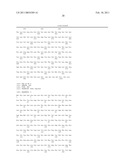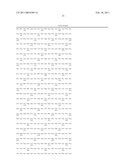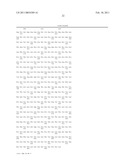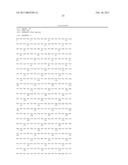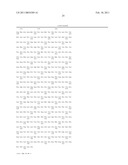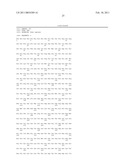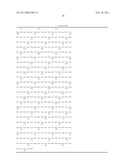Patent application title: ACTIVE AGENTS, COMPOSITIONS, AND METHODS FOR INHIBITING AND REVERSING PLATELET FUNCTION
Inventors:
Dean Y, Li (Salt Lake City, UT, US)
Matthew Smith (Salt Lake City, UT, US)
Andy Weyrich (Salt Lake City, UT, US)
Assignees:
UNIVERSITY OF UTAH RESEARCH FOUNDATION
IPC8 Class: AA61K3817FI
USPC Class:
514 138
Class name: Blood affecting or blood protein utilizing coagulation affecting platelet aggregation or adhesion affecting
Publication date: 2011-02-10
Patent application number: 20110034389
Claims:
1. A composition for inhibiting platelet function, the composition
comprising a Sema3E polypeptide.
2. A composition according to claim 1, wherein the Sema3E polypeptide is a mammalian Sema3E polypeptide.
3. A composition according to any preceding claim, wherein the Sema3E polypeptide is selected from a human Sema3E polypeptide and a mouse Sema3E polypeptide.
4. A composition according to any preceding claim, wherein the Sema3E polypeptide is selected from an isolated and purified, full-length, naturally occurring mammalian Sema3E polypeptide, a Sema3E polypeptide according to SEQ. ID. NO. 1, a Sema3E polypeptide according to SEQ. ID. NO. 2, a Sema3E polypeptide according to SEQ. ID. NO. 5, and a Sema3E polypeptide according to SEQ. ID. NO. 6.
5. A composition according to claim 4, wherein the Sema3E polypeptide is selected from an analog, homolog, or derivative of an isolated and purified, full-length, naturally occurring mammalian Sema3E polypeptide, a Sema3E polypeptide according to SEQ. ID. NO. 1, a Sema3E polypeptide according to SEQ. ID. NO. 2, a Sema3E polypeptide according to SEQ. ID. NO. 5, and a Sema3E polypeptide according to SEQ. ID. NO. 6, wherein said analog, homolog, or derivative exhibits a polypeptide sequence homology of at least about 80%, 81%, 82%, 83%, 84%, 85%, 86%, 87%, 88%, 89%, 90%, 91%, 92%, 93%, 94%, 95%, 96%, 97%, 98%, 99% or greater to the relevant full-length, naturally occurring mammalian Sema3E, or to SEQ. ID. NO. 1, SEQ. ID. NO. 2, SEQ. ID. NO. 5, or SEQ. ID. NO. 6.
6. A composition according to claim 4, wherein the Sema3E polypeptide is selected from an analog, homolog, or derivative of an isolated and purified, full-length, naturally occurring mammalian Sema3E polypeptide, a Sema3E polypeptide according to SEQ. ID. NO. 1, a Sema3E polypeptide according to SEQ. ID. NO. 2, a Sema3E polypeptide according to SEQ. ID. NO. 5, and a Sema3E polypeptide according to SEQ. ID. NO. 6., wherein said analog, homolog, or derivative exhibits a polypeptide sequence homology selected from one of 80% or less, 70% or less, 60% or less, or 50% or less to the relevant full-length, naturally occurring human or mouse Sema3E, or to SEQ. ID. NO. 1, SEQ. ID. NO. 2, SEQ. ID. NO. 5, or SEQ. ID. NO. 6.
7. A composition according to any preceding claim wherein the Sema3E polypeptide inhibits one or more of platelet spreading, adhesion, aggregation, α-granule release and clotting.
8. A composition according to any preceding claim, wherein the Sema3E polypeptide inhibits each of platelet spreading, adhesion, aggregation, α-granule release and clotting.
9. A composition according to any of claims 1 through 6, wherein the Sema3E polypeptide reverses one or more of platelet spreading, adhesion, aggregation, and clotting.
10. A composition according to any of claims 1 through 6 and 9, wherein the Sema3E polypeptide reverses each of more of platelet spreading, adhesion, aggregation, and clotting.
11. A composition according to any preceding claim, wherein the platelets are human platelets.
12. A composition according to any preceding claim, wherein the composition is a pharmaceutical formulation and further comprises a pharmaceutically acceptable carrier.
13. A composition according to claim 12, wherein the pharmaceutical formulation further comprises one or more pharmaceutically acceptable excipients.
14. A composition according to any preceding claim, wherein the Sema3E polypeptide inhibits activation of Rap1b.
15. A composition according to any preceding claim, wherein the Sema3E polypeptide binds to and is biologically active at a plexin receptor.
16. A composition according to claim 15, wherein the Sema3E binds to and is active at a PlexinD1 receptor.
17. A composition according to claim 15, wherein the Sema3E binds to and is active at a PlexinD1 receptor and a Plexin A receptor selected from Plexin A1 through Plexin A4.
18. A method for inhibiting the function of platelet cells, the method comprising providing a Sema3E polypeptide and exposing said platelet cells to said Sema3E polypeptide.
19. A method according to claim 18, wherein providing a Sema3E polypeptide comprises providing a mammalian Sema3E polypeptide.
20. A method according to either of claim 18 or 19, wherein providing a Sema3E polypeptide comprises providing a polypeptide selected from a human Sema3E polypeptide and a mouse Sema3E polypeptide.
21. A method according to any of claims 18 through 20, wherein providing a Sema3E polypeptide comprises providing a polypeptide selected from an isolated and purified, full-length, naturally occurring mammalian Sema3E polypeptide, a Sema3E polypeptide according to SEQ. ID. NO. 1, a Sema3E polypeptide according to SEQ. ID. NO. 2, a Sema3E polypeptide according to SEQ. ID. NO. 5, and a Sema3E polypeptide according to SEQ. ID. NO. 6.
22. A method according to any of claims 18 through 21, wherein providing a Sema3E polypeptide comprises providing a polypeptide selected from an analog, homolog, or derivative of an isolated and purified, full-length, naturally occurring mammalian Sema3E polypeptide, a Sema3E polypeptide according to SEQ. ID. NO. 1, a Sema3E polypeptide according to SEQ. ID. NO. 2, a Sema3E polypeptide according to SEQ. ID. NO. 5, and a Sema3E polypeptide according to SEQ. ID. NO. 6, wherein said analog, homolog, or derivative exhibits a polypeptide sequence homology of at least about 80%, 81%, 82%, 83%, 84%, 85%, 86%, 87%, 88%, 89%, 90%, 91%, 92%, 93%, 94%, 95%, 96%, 97%, 98%, 99% or greater to the relevant full-length, naturally occurring mammalian Sema3E, or to SEQ. ID. NO. 1, SEQ. ID. NO. 2, SEQ. ID. NO. 5, or SEQ. ID. NO. 6.
23. A method according to any of claims 18 through 21, wherein providing a Sema3E polypeptide comprises providing a polypeptide selected from an analog, homolog, or derivative of an isolated and purified, full-length, naturally occurring mammalian Sema3E polypeptide, a Sema3E polypeptide according to SEQ. ID. NO. 1, a Sema3E polypeptide according to SEQ. ID. NO. 2, a Sema3E polypeptide according to SEQ. ID. NO. 5, and a Sema3E polypeptide according to SEQ. ID. NO. 6, wherein said analog, homolog, or derivative exhibits a polypeptide sequence homology selected from one of 80% or less, 70% or less, 60% or less, or 50% or less to the relevant full-length, naturally occurring mammalian Sema3E, or to SEQ. ID. NO. 1, SEQ. ID. NO. 2, SEQ. ID. NO. 5, or SEQ. ID. NO. 6.
24. A method according to any of claims 18 through 23, wherein exposing said platelet cells to said Sema3E polypeptide inhibits one or more of platelet spreading, adhesion, aggregation, α-granule release and clotting.
25. A method according to any of claims 18 through 24, wherein exposing said platelet cells to said Sema3E polypeptide inhibits each of platelet spreading, adhesion, aggregation, α-granule release and clotting.
26. A method according to any of claims 18 through 25, wherein exposing said platelet cells to said Sema3E polypeptide, comprises exposing human platelet cells to said Sema3E polypeptide.
27. A method according to any of claims 18 through 26, wherein providing a Sema3E polypeptide comprises providing a pharmaceutical formulation comprising a Sema3E polypeptide and a pharmaceutically acceptable carrier.
28. A method according to claim 27, wherein the pharmaceutical formulation comprising a Sema3E polypeptide further comprises one or more pharmaceutically acceptable excipients.
29. A method according to any of claims 18 through 28, wherein providing a Sema3E polypeptide comprises providing a Sema3E polypeptide that binds to and is biologically active at a plexin receptor.
30. A method according to any of claims 18 through 29, wherein providing a Sema3E polypeptide comprises providing a Sema3E polypeptide that binds to and is biologically active at a PlexinD1 receptor.
31. A method according to any of claims 18 through 30, wherein providing a Sema3E polypeptide comprises providing a Sema3E polypeptide that binds to and is biologically active at a PlexinD1 receptor and a Plexin A receptor selected from Plexin A1 through Plexin A4.
32. A method according to any of claims 18 through 31, wherein exposing said platelet cells to said Sema3E polypeptide results in inhibition of activation of Rap1b.
33. A method for reversing the function of platelet cells, the method comprising providing a Sema3E polypeptide and exposing said platelet cells to said Sema3E polypeptide.
34. A method according to claim 33, wherein providing a Sema3E polypeptide comprises providing a mammalian Sema3E polypeptide.
35. A method according to either of claim 33 or 34, wherein providing a Sema3E polypeptide comprises providing a polypeptide selected from a human Sema3E polypeptide and a mouse Sema3E polypeptide.
36. A method according to any of claims 33 through 35, wherein providing a Sema3E polypeptide comprises providing a polypeptide selected from an isolated and purified, full-length, naturally occurring mammalian Sema3E polypeptide, a Sema3E polypeptide according to SEQ. ID. NO. 1, a Sema3E polypeptide according to SEQ. ID. NO. 2, a Sema3E polypeptide according to SEQ. ID. NO. 5, and a Sema3E polypeptide according to SEQ. ID. NO. 6.
37. A method according to any of claims 33 through 36, wherein providing a Sema3E polypeptide comprises providing a polypeptide selected from an analog, homolog, or derivative of an isolated and purified, full-length, naturally occurring mammalian Sema3E polypeptide, a Sema3E polypeptide according to SEQ. ID. NO. 1, a Sema3E polypeptide according to SEQ. ID. NO. 2, a Sema3E polypeptide according to SEQ. ID. NO. 5, and a Sema3E polypeptide according to SEQ. ID. NO. 6, wherein said analog, homolog, or derivative exhibits a polypeptide sequence homology of at least about 80%, 81%, 82%, 83%, 84%, 85%, 86%, 87%, 88%, 89%, 90%, 91%, 92%, 93%, 94%, 95%, 96%, 97%, 98%, 99% or greater to the relevant full-length, naturally occurring mammalian Sema3E, or to SEQ. ID. NO. 1, SEQ. ID. NO. 2, SEQ. ID. NO. 5, or SEQ. ID. NO. 6.
38. A method according to any of claims 33 through 36, wherein providing a Sema3E polypeptide comprises providing a polypeptide selected from an analog, homolog, or derivative of an isolated and purified, full-length, naturally occurring mammalian Sema3E polypeptide, a Sema3E polypeptide according to SEQ. ID. NO. 1, a Sema3E polypeptide according to SEQ. ID. NO. 2, a Sema3E polypeptide according to SEQ. ID. NO. 5, and a Sema3E polypeptide according to SEQ. ID. NO. 6, wherein said analog, homolog, or derivative exhibits a polypeptide sequence homology selected from one of 80% or less, 70% or less, 60% or less, or 50% or less to the relevant full-length, naturally occurring mammalian Sema3E, or to SEQ. ID. NO. 1, SEQ. ID. NO. 2, SEQ. ID. NO. 5, or SEQ. ID. NO. 6.
39. A method according to any of claims 33 through 38, wherein exposing said platelet cells to said Sema3E polypeptide reverses one or more of platelet spreading, adhesion, aggregation, and clotting.
40. A method according to any of claims 33 through 39, wherein exposing said platelet cells to said Sema3E polypeptide reverses each of platelet spreading, adhesion, aggregation, and clotting.
41. A method according to any of claims 33 through 40, wherein exposing said platelet cells to said Sema3E polypeptide, comprises exposing human platelet cells to said Sema3E polypeptide.
42. A method according to any of claims 33 through 41, wherein providing a Sema3E polypeptide comprises providing a pharmaceutical formulation comprising a Sema3E polypeptide and a pharmaceutically acceptable carrier.
43. A method according to claim 42, wherein the pharmaceutical formulation comprising a Sema3E polypeptide further comprises one or more pharmaceutically acceptable excipients.
44. A method according to any of claims 33 through 43, wherein providing a Sema3E polypeptide comprises providing a Sema3E polypeptide that binds to and is biologically active at a plexin receptor.
45. A method according to any of claims 33 through 44, wherein providing a Sema3E polypeptide comprises providing a Sema3E polypeptide that binds to and is biologically active at a PlexinD1 receptor.
46. A method according to any of claims 33 through 45, wherein providing a Sema3E polypeptide comprises providing a Sema3E polypeptide that binds to and is biologically active at a PlexinD1 receptor and a Plexin A receptor selected from Plexin A1 through Plexin A4.
47. A method according to any of claims 33 through 46, wherein exposing said platelet cells to said Sema3E polypeptide results in inhibition of activation of Rap1b.
48. A method for treating a patient at risk for a pathologic condition associated with one or more platelet function, the method comprising identifying a patient at risk for a pathologic condition associated with one or more of platelet spreading, adhesion, aggregation, α-granule release and clotting and administering a therapeutically effective amount of a Sema3E polypeptide to said patient.
49. A method according to claim 48, wherein the pathologic condition is selected from stroke, myocardial infarction, unstable angina, angina, thrombosis, including deep venous thrombosis, pulmonary embolism, and atrial fibrillation.
50. A method according to either of claims 48 and 49, wherein administering a therapeutically effective amount of a Sema3E polypeptide to said patient comprises administering a mammalian Sema3E polypeptide.
51. A method according to any of claims 48 through 50, wherein administering a therapeutically effective amount of a Sema3E polypeptide to said patient comprises administering a polypeptide selected from a human Sema3E polypeptide and a mouse Sema3E polypeptide.
52. A method according to any of claims 48 through 51, wherein administering a therapeutically effective amount of a Sema3E polypeptide to said patient comprises administering a polypeptide selected from an isolated and purified, full-length, naturally occurring mammalian Sema3E polypeptide, a Sema3E polypeptide according to SEQ. ID. NO. 1, a Sema3E polypeptide according to SEQ. ID. NO. 2, a Sema3E polypeptide according to SEQ. ID. NO. 5, and a Sema3E polypeptide according to SEQ. ID. NO. 6.
53. A method according to any of claims 48 through 52, wherein administering a therapeutically effective amount of a Sema3E polypeptide to said patient comprises administering a polypeptide selected from an analog, homolog, or derivative of an isolated and purified, full-length, naturally occurring mammalian Sema3E polypeptide, a Sema3E polypeptide according to SEQ. ID. NO. 1, a Sema3E polypeptide according to SEQ. ID. NO. 2, a Sema3E polypeptide according to SEQ. ID. NO. 5, and a Sema3E polypeptide according to SEQ. ID. NO. 6, wherein said analog, homolog, or derivative exhibits a polypeptide sequence homology of at least about 80%, 81%, 82%, 83%, 84%, 85%, 86%, 87%, 88%, 89%, 90%, 91%, 92%, 93%, 94%, 95%, 96%, 97%, 98%, 99% or greater to the relevant full-length, naturally occurring mammalian Sema3E, or to SEQ. ID. NO. 1, SEQ. ID. NO. 2, SEQ. ID. NO. 5, or SEQ. ID. NO. 6.
54. A method according to any of claims 48 through 52, wherein administering a therapeutically effective amount of a Sema3E polypeptide to said patient comprises administering a polypeptide selected from an analog, homolog, or derivative of an isolated and purified, full-length, naturally occurring mammalian Sema3E polypeptide, a Sema3E polypeptide according to SEQ. ID. NO. 1, a Sema3E polypeptide according to SEQ. ID. NO. 2, a Sema3E polypeptide according to SEQ. ID. NO. 5, and a Sema3E polypeptide according to SEQ. ID. NO. 6, wherein said analog, homolog, or derivative exhibits a polypeptide sequence homology selected from one of 80% or less, 70% or less, 60% or less, or 50% or less to the relevant full-length, naturally occurring mammalian Sema3E, or to SEQ. ID. NO. 1, SEQ. ID. NO. 2, SEQ. ID. NO. 5, or SEQ. ID. NO. 6.
55. A method according to any of claims 48 through 54, wherein administering a therapeutically effective amount of a Sema3E polypeptide to said patient inhibits one or more of platelet spreading, adhesion, aggregation, α-granule release and clotting.
56. A method according to any of claims 48 through 55, wherein administering a therapeutically effective amount of a Sema3E polypeptide to said patient inhibits each of platelet spreading, adhesion, aggregation, α-granule release and clotting.
57. A method according to any of claims 48 through 56, wherein administering a therapeutically effective amount of a Sema3E polypeptide to said patient comprises administering a pharmaceutical formulation comprising a Sema3E polypeptide and a pharmaceutically acceptable carrier.
58. A method according to claim 57, wherein the pharmaceutical formulation comprising a Sema3E polypeptide further comprises one or more pharmaceutically acceptable excipients.
59. A method according to any of claims 48 through 58, wherein administering a therapeutically effective amount of a Sema3E polypeptide to said patient comprises administering a Sema3E polypeptide that binds to and is biologically active at a plexin receptor.
60. A method according to any of claims 48 through 59, wherein administering a therapeutically effective amount of a Sema3E polypeptide to said patient comprises administering a Sema3E polypeptide that binds to and is biologically active at a PlexinD1 receptor.
61. A method according to any of claims 48 through 60, wherein administering a therapeutically effective amount of a Sema3E polypeptide to said patient comprises administering a Sema3E polypeptide that binds to and is biologically active at a PlexinD1 receptor and a Plexin A receptor selected from Plexin A1 through Plexin A4.
62. A method according to any of claims 48 through 61, wherein administering a therapeutically effective amount of a Sema3E polypeptide to said patient results in inhibition of activation of Rap1b in one or more platelet cells.
63. A method for treating a patient suffering from a pathologic condition associated with one or more platelet function, the method comprising identifying a patient suffering from a pathologic condition associated with one or more of platelet spreading, adhesion, aggregation, α-granule release and clotting and administering a therapeutically effective amount of a Sema3E polypeptide to said patient.
64. A method according to claim 63, wherein the pathologic condition is selected from stroke, myocardial infarction, unstable angina, angina, thrombosis, including deep venous thrombosis, pulmonary embolism, and atrial fibrillation.
65. A method according to either of claims 63 and 64, wherein administering a therapeutically effective amount of a Sema3E polypeptide to said patient comprises administering a mammalian Sema3E polypeptide.
66. A method according to any of claims 63 through 65, wherein administering a therapeutically effective amount of a Sema3E polypeptide to said patient comprises administering a polypeptide selected from a human Sema3E polypeptide and a mouse Sema3E polypeptide.
67. A method according to any of claims 63 through 66, wherein administering a therapeutically effective amount of a Sema3E polypeptide to said patient comprises administering a polypeptide selected from an isolated and purified, full-length, naturally occurring mammalian Sema3E polypeptide, a Sema3E polypeptide according to SEQ. ID. NO. 1, a Sema3E polypeptide according to SEQ. ID. NO. 2, a Sema3E polypeptide according to SEQ. ID. NO. 5, and a Sema3E polypeptide according to SEQ. ID. NO. 6.
68. A method according to any of claims 63 through 67, wherein administering a therapeutically effective amount of a Sema3E polypeptide to said patient comprises administering a polypeptide selected from an analog, homolog, or derivative of an isolated and purified, full-length, naturally occurring mammalian Sema3E polypeptide, a Sema3E polypeptide according to SEQ. ID. NO. 1, a Sema3E polypeptide according to SEQ. ID. NO. 2, a Sema3E polypeptide according to SEQ. ID. NO. 5, and a Sema3E polypeptide according to SEQ. ID. NO. 6, wherein said analog, homolog, or derivative exhibits a polypeptide sequence homology of at least about 80%, 81%, 82%, 83%, 84%, 85%, 86%, 87%, 88%, 89%, 90%, 91%, 92%, 93%, 94%, 95%, 96%, 97%, 98%, 99% or greater to the relevant full-length, naturally occurring mammalian Sema3E, or SEQ. ID. NO. 1, SEQ. ID. NO. 2, SEQ. ID. NO. 5, or SEQ. ID. NO. 6.
69. A method according to any of claims 63 through 67, wherein administering a therapeutically effective amount of a Sema3E polypeptide to said patient comprises administering a polypeptide selected from an analog, homolog, or derivative of an isolated and purified, full-length, naturally occurring mammalian Sema3E polypeptide, a Sema3E polypeptide according to SEQ. ID. NO. 1, a Sema3E polypeptide according to SEQ. ID. NO. 2, a Sema3E polypeptide according to SEQ. ID. NO. 5, and a Sema3E polypeptide according to SEQ. ID. NO. 6, wherein said analog, homolog, or derivative exhibits a polypeptide sequence homology selected from one of 80% or less, 70% or less, 60% or less, or 50% or less to the relevant full-length, naturally occurring mammalian Sema3E, or to SEQ. ID. NO. 1, SEQ. ID. NO. 2, SEQ. ID. NO. 5, or SEQ. ID. NO. 6.
70. A method according to any of claims 63 through 69, wherein administering a therapeutically effective amount of a Sema3E polypeptide to said patient inhibits one or more of platelet spreading, adhesion, aggregation, α-granule release and clotting.
71. A method according to any of claims 63 through 70, wherein administering a therapeutically effective amount of a Sema3E polypeptide to said patient inhibits each of platelet spreading, adhesion, aggregation, α-granule release and clotting.
72. A method according to any of claims 63 through 69, wherein administering a therapeutically effective amount of a Sema3E polypeptide to said patient reverses one or more of platelet spreading, adhesion, aggregation, and clotting.
73. A method according to any of claims 63 through 69, wherein administering a therapeutically effective amount of a Sema3E polypeptide to said patient reverses each of platelet spreading, adhesion, aggregation, and clotting.
74. A method according to any of claims 63 through 73, wherein administering a therapeutically effective amount of a Sema3E polypeptide to said patient comprises administering a pharmaceutical formulation comprising a Sema3E polypeptide and a pharmaceutically acceptable carrier.
75. A method according to claim 74, wherein the pharmaceutical formulation comprising a Sema3E polypeptide further comprises one or more pharmaceutically acceptable excipients.
76. A method according to any of claims 63 through 75, wherein administering a therapeutically effective amount of a Sema3E polypeptide to said patient comprises administering a Sema3E polypeptide that binds to and is biologically active at a plexin receptor.
77. A method according to any of claims 63 through 76, wherein administering a therapeutically effective amount of a Sema3E polypeptide to said patient comprises administering a Sema3E polypeptide that binds to and is biologically active at a PlexinD1 receptor.
78. A method according to any of claims 63 through 77, wherein administering a therapeutically effective amount of a Sema3E polypeptide to said patient comprises administering a Sema3E polypeptide that binds to and is biologically active at a PlexinD1 receptor and a Plexin A receptor selected from Plexin A1 through Plexin A4.
79. A method according to any of claims 63 through 78, wherein administering a therapeutically effective amount of a Sema3E polypeptide to said patient results in inhibition of activation of Rap1b in one or more platelet cells.
Description:
BACKGROUND
[0002]Platelets, or thrombocytes, play a fundamental role in hemostasis, leading to the formation of blood clots. If the number of platelets is too low or if platelets become dysfunctional, excessive bleeding can occur. However, platelet activation and function are also associated with various pathologic conditions, such as stroke, heart attack, pulmonary embolism, unstable angina, angina, atrial fibrillation, and thrombosis associated with the blockage of blood vessels to other parts of the body, such as the extremities of the arms or legs (e.g., deep venous thrombosis).
[0003]Platelet function can be triggered by injury, or by one of several agonists, including thrombin, thromboxane, such as thromboxane A2, and adenosine diphosphate ("ADP"). Platelet activity is associated with one or more of platelet spreading, platelet adhesion, platelet aggregation, α-granule release, and clotting (thrombosis). Active agents and compositions capable of inhibiting platelet activity (e.g., one, more, or all of platelet spreading, adhesion, aggregation, α-granule release, and clotting) would be useful in methods for preventing or treating the serious pathologic conditions associated with platelet activity.
SUMMARY
[0004]Active agents and compositions for inhibiting and reversing platelet function are provided herein. In particular embodiments, the active agents and compositions provided herein inhibit or reverse platelet function promoted by multiple agonists. The active agents described herein inhibit or reverse one or more platelet functions selected from platelet spreading, adhesion, aggregation, α-granule release, and clotting, and in specific embodiments the active agents include semaphorin 3E ("Sema3E") polypeptides. For example, in specific embodiments, the active agent is selected from mammalian Sema3E polypeptides, such as a human or mouse Sema3E, as well as derivatives, homologs, and analogs of such polypeptides that inhibit or reverse platelet function. As is described herein, it has been found that Sema3E polypeptides are not only potent inhibitors of platelet function, but Sema3E polypeptides are also capable of reversing platelet function. The compositions as described herein include one or more active agents according to the present description. In particular embodiments, the compositions described herein are pharmaceutical formulations.
[0005]Methods of inhibiting or reversing platelet function are also provided herein. In specific embodiments, the methods include administering an active agent, wherein administering such active agent results in inhibition or reversal of platelet activity. In one such embodiment, the active agent administered is an active agent as described herein and administration of the active agent results in inhibition or reversal of one or more platelet functions selected from platelet spreading, adhesion, aggregation, α-granule release, and clotting. In another such embodiment, administering an active agent as described herein inhibits activation of Rap1b, resulting in inhibition of activation of αIIbβ3 integrin. In yet another embodiment, administering an active agent as described herein promotes activation of one or more plexin receptors, resulting in inhibition or reversal of one or more platelet functions as described herein.
[0006]In each embodiment, where an active agent is administered to inhibit or reverse platelet function, such active agent can be an active agent as described herein and, if desired, can be administered in a composition as described herein, such as a pharmaceutical formulation. Therefore, in specific embodiments, the methods for inhibiting or reversing platelet function described herein include administering an active agent selected from mammalian Sema3E polypeptides, such as a human or mouse Sema3E, as well as derivatives, homologs, and analogs of such polypeptides that inhibit activation of Rap1b. In additional embodiments, the methods for inhibiting or reversing platelet function described herein include administering an active agent selected from mammalian Sema3E polypeptides, such as a human or mouse Sema3E, as well as derivatives, homologs, and analogs of such polypeptides, that bind to and are biologically active at one or more plexin receptors.
[0007]Methods of treating pathologic conditions associated with platelet function are also described herein. A pathologic condition treated by the methods described herein may be selected from pathologic conditions associated with one or more of platelet spreading, adhesion, aggregation, α-granule release, and clotting. Specific examples of such conditions include, but are not limited to, stroke, myocardial infarction, unstable angina, angina, thrombosis, including deep venous thrombosis, pulmonary embolism, and atrial fibrillation. In one embodiment, a method of treatment as described herein, includes administering a therapeutically effective amount of an active agent as described herein to a patient suffering from a pathologic condition resulting from one or more of platelet spreading, adhesion, aggregation, α-granule release or clotting. In one such embodiment, the method includes administering a therapeutically effective amount of an active agent as described herein to a patient suffering from a condition selected from stroke, myocardial infarction, unstable angina, angina, thrombosis, including deep venous thrombosis, pulmonary embolism, and atrial fibrillation. The active agent administered in the methods described herein may be a polypeptide active agent, such as, for example, a Sema3E polypeptide. For example, in one embodiment, a method as described herein includes administering a mammalian Sema3E polypeptide selected from a human or mouse Sema3E polypeptide, as well as derivatives, homologs, and analogs of such polypeptides, wherein the polypeptide administered inhibits or reverses one or more platelet function.
[0008]In certain embodiments, the methods for treating a pathologic condition associated with platelet function include inhibiting activation of Rap1b. Rap1b activation is a common feature of platelet activity. In particular it is believed that activation of Rap1b is necessary for activation of αIIbβ3 integrin. In one such embodiment, therefore, a method for treating a pathologic condition associated with platelet function includes inhibiting activation of Rap1b activation such that activation of αIIbβ3 integrin is inhibited. In specific embodiments, the methods for treating a pathologic condition associated with platelet function by inhibition of Rap1b include administering a Sema3E polypeptide as described herein. For example, in one such embodiment, the method includes administering a therapeutically effective amount of a mammalian Sema3E polypeptide, such as a human or mouse Sema3E, including derivatives, homologs, and analogs of such polypeptides, wherein the polypeptide administered inhibits activation of Rap1b. The pathologic condition treated by a method involving inhibition of activation of Rap1b can be selected from conditions resulting from or associated with one or more of platelet spreading, adhesion, aggregation, α-granule release or clotting, including, by way of example and not limitation, stroke, myocardial infarction, unstable angina, angina, thrombosis, including deep venous thrombosis, pulmonary embolism, and atrial fibrillation.
[0009]In yet another embodiment, a method of treating a pathologic condition associated with platelet function as described herein includes administering an active agent that activates one or more plexin receptors. In one such embodiment, therefore, a method for treating a pathologic condition associated with platelet function includes administering a Sema3E polypeptide that binds to and is biologically active at one or more plexin receptors, such as Plexin D1 or a receptor selected from the Plexin A family of receptors. In one such embodiment, the active agent for administration may be selected from a mammalian Sema3E polypeptide, such as a human or mouse Sema3E, including derivatives, homologs, and analogs of such polypeptides, wherein the polypeptide administered binds to and is biologically active at one or more plexin receptors. The pathologic condition treated by a method involving administration of an active agent that is biologically active at one or more plexin receptors can be selected from conditions resulting from or associated with one or more of platelet spreading, adhesion, aggregation, α-granule release or clotting, including, by way of example and not limitation, stroke, myocardial infarction, unstable angina, angina, thrombosis, including deep venous thrombosis, pulmonary embolism, and atrial fibrillation.
[0010]Methods of screening for compositions capable of modulating platelet function are also described herein. In particular embodiments, the screening methods described herein included evaluating the ability of one or more active agents or compositions to activate one or more plexin receptors, such as PlexinD1 or inhibit activation of Rap1b.
BRIEF DESCRIPTION OF THE DRAWINGS
[0011]The accompanying drawings, which are incorporated in and constitute a part of this specification, illustrate several embodiments of the disclosed active agents, compositions, and method and, together with the description, serve to explain the principles of the disclosed method and compositions.
[0012]FIG. 1 illustrates that PlexinD1 is expressed at the cellular membrane of platelets. As can be seen in panel B of FIG. 1, CHO-PD1 cells, which express the PlexinD1 receptor, exhibited anti-PlexinD1 staining at the cell membrane. As is shown in panels C and D of FIG. 1, Anti-PlexinD1 staining was observed at the cell membrane in both human and mouse platelets.
[0013]FIG. 2 provides images that illustrate the differences in potency observed with different semaphorin proteins. Panel A of FIG. 2 provides an image that is illustrative of the results achieved with human platelet cells incubated with a vehicle only. Panels B, E, and F, provide images that are illustrative of the results achieved with human platelet cells incubated with Netrin 1, Slit2, and Netrin 4, respectively. Panels C, D, and G, provide images illustrative of the results achieved with human platelet cells incubated with Sema3A, Sema3F, and Sema3E polypeptides, respectively. As can be appreciated from FIG. 2, the effect of the Sema3E polypeptide was particularly potent. Panel H provides an image illustrating the effect of Sema3E is reversible, as removal and washing of the Sema3E containing media restored the platelets' ability to spread.
[0014]FIG. 3 provides images illustrating that the activity of Sema3E is preserved in mouse platelets. In particular, Panel A provides an image of mouse platelets incubated on borosilicate chamber slides coated with fibrinogen in the presence of a vehicle only, while Panel B provides an image of mouse platelets incubated on borosilicate chamber slides coated with fibrinogen in the presence of Sema3E.
[0015]FIG. 4 provides images illustrating that the activity of Sema3E is not agonist dependent. Panel A provides an image of platelets incubated with ADP in the presence of a vehicle only, while Panel B provides an image of mouse platelets incubated with ADP in the presence of Sema3E.
[0016]FIG. 5 provides images illustrating that Sema3E inhibits platelet attachment and spreading on β3 and β1 integrin-dependent substrates. Human platelets were incubated with a vehicle only or with media containing hSema3E and then placed on chamber slides coated with the designated substrates in the presence of thrombin. As can be appreciated by comparison between to the panels associated with cells incubated with hSema3E and cells incubated with vehicle only, Sema3E works to inhibit thrombin-induced platelet spreading and attachment on each of the substrates.
[0017]FIG. 6 provides images illustrating that Sema3E/PlexinD1 signaling are sufficient to cause cellular contraction. CHO-PLA1 cells transiently transfected with hPlexinD1 were allowed to spread on fibrinogen coated chamber slides and stained for imaging. Panel A shows a CHO-PD1 cell that expressed PlexinD1 at the membrane but was not exposed to hSema3E. Panel B shows a cell from the same cell line after exposure to hSema3E. As can be seen in Panel B, treatment with Sema3E causes cell collapse and possible endocytosis of the receptor.
[0018]FIG. 7 provides a graphed representation of experimental results demonstrating that Sema3E inhibits platelet adhesion to fibrinogen.
[0019]FIG. 8 provides images showing that Sema3E contracts pre-spread platelets. Human platelets were placed on chamber slides coated with fibrinogen and allowed to spread in the presence of 0.05 U/ml thrombin (spread platelets shown in Panel A). The platelets were then treated with a vehicle or media containing hSema3E (Panel B shows platelets post treatment with Sema3E). As can be appreciated by comparison of panel A and panel B, treating pre-spread platelets with hSema3E reversed cellular spreading, resulting in platelet contraction.
[0020]FIG. 9 and FIG. 10 provide two different graphed depictions of experimental results establishing that Sema3E inhibits α-Granule release from platelets.
[0021]FIG. 11 provides a graphed depiction of experimental results establishing that Sema3E (hSema3E) inhibits thrombin-induced P-Selectin translocation in human platelets.
[0022]FIG. 12 provides a graphed depiction of experimental results establishing that Sema3E (recombinant murine semaphorin 3E/Fc) inhibits induced P-Selectin translocation in mouse platelets induced by multiple agonists.
[0023]FIG. 13 depicts the results of a platelet aggregation study, showing that Sema3E inhibits platelet aggregation.
[0024]FIG. 14 provides a graphed depiction of experimental results establishing that Sema3E can both inhibit and reverse activation of αIIbβ3 integrin.
[0025]FIG. 15 and FIG. 16 provide two different graphed depictions of experimental results establishing that Sema3E inhibits activation αIIbβ3 integrin in mouse platelets induced by multiple agonists.
[0026]FIG. 17 and FIG. 18. provide two different graphed depictions of experimental results establishing that Sema3E inhibits clot formation in-vivo. FIG. 17 provides a graphical depiction of relative carotid artery flow observed in a mouse model of FeCl3-induced carotid artery thrombosis, with the different lines representing relative carotid artery flow in mice receiving saline, mice receiving varying doses of heparin, and mice receiving Sema3E. FIG. 18 provides a graphic representation of the time to occlusion of the carotid artery observed in the same mouse model of FeCl3-induced carotid artery thrombosis, with the different bars representing time to occlusion in mice receiving saline, mice receiving varying doses of heparin, and mice receiving Sema3E.
[0027]FIG. 19 provides representative images of ultrasound data obtained in the course of evaluating Sema3E in a mouse model of FeCl3-induced carotid artery thrombosis
[0028]FIG. 20 provides experimental results showing that Sema3E inhibits activation of Rap1b (i.e., formation of GTP-Rap1b).
[0029]FIG. 21 provides the sequence of a recombinant human semaphorin 3E with CD33 Signal peptide and His tag (SEQ. ID. NO. 1).
[0030]FIG. 22 provides the sequence of a recombinant murine semaphorin 3E/Fc with CD33 signal peptide, linker and Fc (SEQ. ID. NO. 2).
[0031]FIG. 23 provides the sequence of a recombinant human semaphorin 3A/Fc with CD33 signal peptide, His tag, linker and Fc (SEQ. ID. NO. 3).
[0032]FIG. 24 provides the sequence of a recombinant murine semaphorin 3F/Fc with CD33 signal peptide, linker and Fc (SEQ. ID. NO. 4).
[0033]FIG. 25 provides the sequence of a recombinant human semaphorin 3E referred to as pCI-His8-hSema3E (SEQ. ID. NO. 5).
[0034]FIG. 26 provides the sequence of a recombinant human semaphorin 3E referred to as pCI-His8-hSema3E-convertase dead KARFAR (SEQ. ID. NO. 6).
DETAILED DESCRIPTION OF THE INVENTION
[0035]Disclosed are materials, compositions, and components that can be used for, can be used in conjunction with, can be used in preparation for, or are products of the disclosed active agents, compositions and methods. These and other materials are disclosed herein, and it is understood that when combinations, subsets, interactions, groups, etc. of these materials are disclosed that, while specific reference of each various individual and collective combinations and permutation of these compounds may not be explicitly disclosed, each is specifically contemplated and described herein. For example, if a polypeptide is disclosed and discussed and a number of modifications that can be made to a number of molecules including the polypeptide are discussed, each and every combination and permutation of polypeptide and the modifications that are possible are specifically contemplated unless specifically indicated to the contrary. Thus, if a class of molecules A, B, and C are disclosed as well as a class of molecules D, E, and F, and an example of a combination molecule, A-D, is disclosed, then even if each is not individually recited, each is individually and collectively contemplated. Thus, is this example, each of the combinations A-E, A-F, B-D, B-E, B-F, C-D, C-E, and C--F are specifically contemplated and should be considered disclosed from disclosure of A, B, and C; D, E, and F; and the example combination A-D. Likewise, any subset or combination of these is also specifically contemplated and disclosed. Thus, for example, the sub-group of A-E, B-F, and C-E are specifically contemplated and should be considered disclosed from disclosure of A, B, and C; D, E, and F; and the example combination A-D. This concept applies to all aspects of this application including, but not limited to, steps in methods of making and using the disclosed compositions. Thus, if there are a variety of additional steps that can be performed it is understood that each of these additional steps can be performed with any specific embodiment or combination of embodiments of the disclosed methods, and that each such combination is specifically contemplated and should be considered disclosed.
[0036]Those skilled in the art will recognize, or be able to ascertain using no more than routine experimentation, many equivalents to the specific embodiments of the method and compositions described herein. Such equivalents are intended to be encompassed by the included claims.
[0037]It is also to be understood that the terminology used herein is for the purpose of describing particular embodiments only, and is not intended to limit the scope of the present invention which will be limited only by the appended claims.
[0038]Unless defined otherwise, all technical and scientific terms used herein have the meanings that would be commonly understood by one of skill in the art in the context of the present specification.
[0039]It must be noted that as used herein and in the appended claims, the singular forms "a," "an," and "the" include plural reference unless the context clearly dictates otherwise. Thus, for example, reference to "a polypeptide" includes a plurality of such polypeptides, reference to "the polypeptide" is a reference to one or more polypeptides and equivalents thereof known to those skilled in the art, and so forth.
[0040]"Optional" or "optionally" means that the subsequently described event, circumstance, or material may or may not occur or be present, and that the description includes instances where the event, circumstance, or material occurs or is present and instances where it does not occur or is not present.
[0041]Ranges can be expressed herein as from "about" one particular value, and/or to "about" another particular value. When such a range is expressed, another embodiment includes from the one particular value and/or to the other particular value. Similarly, when values are expressed as approximations, by use of the antecedent "about," it will be understood that the particular value forms another embodiment. It will be further understood that the endpoints of each of the ranges are significant both in relation to the other endpoint, and independently of the other endpoint. It is also understood that there are a number of values disclosed herein, and that each value is also herein disclosed as "about" that particular value in addition to the value itself. For example, if the value "10" is disclosed, then "about 10" is also disclosed. It is also understood that each unit between two particular units are also disclosed. For example, if 10 and 15 are disclosed, then 11, 12, 13, and 14 are also disclosed.
[0042]As used herein, the term "subject" means any target of administration. The subject can be a vertebrate, for example, a mammal. Thus, the subject can be a human. The term does not denote a particular age or sex. Thus, adult and newborn subjects, as well as fetuses, whether male or female, are intended to be covered. The term "patient" refers to a subject afflicted with a pathologic condition. The term "patient" includes human and veterinary subjects.
[0043]"Inhibit," "inhibiting," and "inhibition" mean to prevent, decrease, or inactivate an activity, response, condition, disease, or other biological parameter. This can include, but is not limited to the complete ablation of the activity, response, condition, or disease. This may also include, for example, a slowing or reduction of an activity, response, condition, disease, or other biological parameter as compared to a native level, with the term "native level" referring to a level evident in the absence of an inhibiting agent. In this context, a reduction can be any measurable reduction. In particular embodiments, a reduction can be, for example, a 10%, 20%, 30%, 40%, 50%, 60%, 70%, 80%, 90%, 100%, or any amount of reduction in between the specifically recited percentages, as compared to a native level.
[0044]As it is used herein in association with platelet activity, the term "reverse" specifically refers to reverting, at least in part, an activity, response, condition, disease, or other biological parameter associated with the presence or production of an agonist, such as thrombin, ADP, or thromboxane, such as thromboxane A2, to a state that more closely resembles the absence of the agonist. In this context, "reverting" can be a reduction in the activity, response, condition, disease, or other biological parameter associated with the presence or production of an agonist. In this context, a reduction can be any measurable reduction. In particular embodiments, a reduction can be, for example, a 10%, 20%, 30%, 40%, 50%, 60%, 70%, 80%, 90%, 100%, or any amount of reduction in between the specifically recited percentages, as compared to a native level. Therefore, the term "reverting" encompasses a complete reversal of an activity, response, condition, disease, or other biological parameter associated with the presence or production of an agonist.
[0045]"Promote," "promotion," and "promoting" refer to an increase in an activity, response, condition, disease, or other biological parameter. This can include but is not limited to the initiation of the activity, response, condition, or disease. This may also include, for example, a 10% increase in the activity, response, condition, or disease as compared to the native or control level. Thus, the increase in an activity, response, condition, disease, or other biological parameter can be a 10%, 20%, 30%, 40%, 50%, 60%, 70%, 80%, 90%, 100%, or more, including any amount of increase in between the specifically recited percentages, as compared to native or control levels.
[0046]The term "carrier" means a compound, composition, substance, or structure that, when in combination with a compound or composition, aids or facilitates preparation, storage, administration, delivery, effectiveness, selectivity, or any other feature of the compound or composition for its intended use or purpose. For example, a carrier can be used in providing a pharmaceutical formulation and can be selected to minimize any degradation of the active agent and to minimize any adverse side effects in the subject.
[0047]When referring to an active agent that is "biologically active" at a plexin receptor, the term "biologically active" refers to active agents which exhibit an association with a plexin receptor, such as active agents that bind to a plexin receptor, and wherein such association is coupled with inhibition or reversal of one or more platelet function, including one or more functions selected from platelet spreading, adhesion, aggregation, α-granule release, and clotting.
[0048]As used herein, the terms "treat," "treating," and "treatment" refer to a therapeutic benefit, whereby the detrimental effect(s) or progress of a particular pathologic condition, disease, condition, event or injury is prevented, reduced, halted, reversed or slowed.
[0049]A "therapeutically effective amount" is the amount of compound which achieves a therapeutic benefit, such as, for example, by inhibiting or reversing an activity, response, condition, disease, or other parameter associated with a pathologic condition. A therapeutically effective amount may be an amount which relieves, at least to some extent, one or more symptoms of a pathologic condition in a subject; returns to normal, either partially or completely, one or more physiological or biochemical parameters associated with or causative of a pathologic condition; and/or reduces the likelihood of the onset of a pathologic condition.
[0050]The terms "pathologic" or "pathologic conditions" refer to any deviation from a healthy, normal, or efficient condition which may be the result of a disease, condition, event or injury.
I. Active Agents & Compositions
[0051]Active agents for inhibiting or reversing the activity of platelets are provided herein. In one embodiment, the active agents inhibit or reverse one or more platelet function. For example, in specific embodiments, the active agents describe herein inhibit or reverse one or more of platelet spreading, adhesion, aggregation, α-granule release, or clotting. In one embodiment, the active agent inhibits or reverses platelet spreading, adhesion, aggregation, α-granule release, and clotting. The active agents described herein may be a polypeptide agent. Specific examples of such polypeptide active agents include polypeptides belonging to or derived from semaphorin 3E proteins ("Sema3E polypeptides" or "Sema3E"). When discussing Sema3E polypeptides as contemplated herein, full-length Sema3E proteins, as well as derivatives, analogs and homologs of full-length Sema3E proteins are contemplated, provided that such polypeptides inhibit or reverse one, or more, or all of platelet spreading, adhesion, aggregation, α-granule release, or clotting. A "derivative" polypeptide molecule refers to a polypeptide formed from native compounds either directly or by modification or partial substitution. A "homolog" polypeptide molecule refers to a polypeptide product of a particular gene derived from a different species. An "analog" polypeptide molecule is a polypeptide that is similar in structure, but not identical, and differs with respect to number or nature of amino acids included in a referenced polypeptide sequence. For example, an analog to a given polypeptide will exhibit a level of sequence homology, but may include one or more amino acid substitutions or deletions.
[0052]In specific embodiments, where the active agent is a Sema3E polypeptide, the active agent may be selected from mammalian Sema3E polypeptides, such as a mouse or human Sema3E polypeptide. Where the active agent is a mammalian Sema3E, the active agent may be selected from known, naturally occurring mammalian Sema3E polypeptides that have been isolated and purified according to techniques known in the art. Alternatively, a mammalian Sema3E as contemplated herein may be obtained through recombinant or synthetic production techniques well know in the art. Even further, the active agent may be selected from derivatives, analogs, or homologs of naturally occurring, recombinant, or synthetic mammalian Sema3E polypeptides. For example, in specific embodiments, the active agent may be selected from the recombinant human Sema3E detailed in FIG. 22 ("hSema3E") (SEQ. ID. NO. 1) and the recombinant murine Sema 3E/Fc detailed in FIG. 23 (SEQ. ID. NO. 2), as well as derivatives, analogs and homologs of such polypeptides exhibiting the ability to inhibit or reverse one or more of platelet spreading, adhesion, aggregation, α-granule release, or clotting. In other embodiments, the active agent may be selected from the recombinant human Sema3E polypeptides detailed in FIG. 25 (SEQ. ID. NO. 5) and FIG. 26 (SEQ. ID. NO. 6), as well as derivatives, analogs and homologs of such polypeptides exhibiting the ability to inhibit or reverse one or more of platelet spreading, adhesion, aggregation, α-granule release, or clotting. In one embodiment, the active agent is selected from a derivative, homolog or analog of a naturally occurring mammalian Sema3E polypeptide, such as a full-length, naturally occurring human or mouse Sema3E, or one of the Sema polypeptides described by SEQ. ID. NO. 1, SEQ. ID. NO. 2, SEQ. ID. NO. 5, and SEQ. ID. NO. 6, with such active agent exhibiting a polypeptide sequence homology of at least about 80%, 81%, 82%, 83%, 84%, 85%, 86%, 87%, 88%, 89%, 90%, 91%, 92%, 93%, 94%, 95%, 96%, 97%, 98%, 99% or greater to the relevant full-length, naturally occurring human or mouse Sema3E, or to SEQ. ID. NO. 1, SEQ. ID. NO. 2, SEQ. ID. NO. 5, or SEQ. ID. NO. 6. In another embodiment, the active agent is a derivative, homolog, or analog of full-length, naturally occurring human or mouse Sema3E or one of Sema 3E polypeptides detailed in SEQ. ID. NO. 1, SEQ. ID. NO. 2, SEQ. ID. NO. 5, and SEQ. ID. NO. 6, yet exhibits less polypeptide sequence homology to the polypeptide from which it is derived, such as, for example, a homology selected from one of 80% or less, 70% or less, 60% or less, or 50% or less, while retaining the ability to inhibit or reverse one or more of platelet spreading, adhesion, aggregation, α-granule release or clotting.
[0053]Semaphorins are known to interact with plexins, and plexin receptors are understood to be the predominant class of semaphorin receptors. There are four classes of plexins, class A-D, and it has been reported that class 3 semaphorins (e.g., Sema 3A, 3C, 3E, and 3F) interact with class A and class D plexins: Sema3A, Sema3C, and Sema3E are known to bind Plexin-D1; Sema3A and Sema3F are known to bind Plexin-A1, Plexin-A3, and Plexin-A4; and Sema3A is known to bind Plexin-A2. (Kruger R. et al. Semaphorins command cells to move. Nature Reviews. Volume 6. Pp 789-800. October 2005). It has been proposed that interactions between class 3 semaphorins and Plexin-A and Plexin-D are essential to the proper formation of vasculature, and it has been reported that class 3 semaphorin signaling mediated by Plexin-D1 is required for normal heart development. (Kruger R. et al. Semaphorins command cells to move. Nature Reviews. Volume 6. Pp 789-800. October 2005).
[0054]As is illustrated by the experimental examples provided herein, Plexin-D1 is expressed at the membrane of platelets, and binding of Sema3E to the Plexin-D1 receptor is sufficient to cause cellular contraction of cells allowed to spread on a fibrinogen containing matrix. Without being bound by a particular theory, therefore, it is believed that platelet function, including platelet spreading, adhesion, aggregation, α-granule release, and clotting, may be inhibited or reversed by activation of a plexin receptor, such as the Plexin-D1 receptor. Therefore, in particular embodiments, the active agents described herein are capable of binding to and are biologically active at one or more plexin receptors. In one such embodiment, the active agent is a Sema3E polypeptide as described herein that binds to and is biologically active at one or more plexin receptors selected from Plexin-D1 and the Plexin-A class of receptors (i.e., Plexin-A1 through Plexin-A4). In one such specific embodiment, the active agent is selected from a Sema3E polypeptide as described herein that binds to and is biologically active at a Plexin-D1 receptor.
[0055]Sema3E polypeptides that are capable of binding to and are biologically active at one or more plexin receptors, as described herein, can be selected from mammalian Sema3E polypeptides, such as a mouse or human Sema3E. Where the active agent is a mammalian Sema3E, the active agent may be selected from naturally occurring mammalian Sema3E polypeptides that have been isolated and purified from their natural environment. Alternatively, a mammalian Sema3E as contemplated herein may be obtained through recombinant or synthetic production techniques well know in the art. Even further, the active agent may be selected from derivatives, analogs, or homologs of naturally occurring, recombinant, or synthetic mammalian Sema3E polypeptides. For example, in specific embodiments, a Sema3E active agent capable of binding to and biologically active at a plexin receptor as described herein may be selected from the recombinant Sema3E polypeptides provided in SEQ. ID. NO. 1, SEQ. ID. NO. 2, SEQ. ID. NO. 5, and SEQ. ID. NO. 6, as well as derivatives, analogs and homologs of such polypeptides that bind to and are biologically active at the desired plexin receptor(s). In one such embodiment, the active agent is selected from a derivative, homolog or analog of a naturally occurring mammalian Sema3E polypeptide, such as a full-length, naturally occurring human or mouse Sema3E, or one of the Sema polypeptides described by SEQ. ID. NO. 1, SEQ. ID. NO. 2, SEQ. ID. NO. 5, and SEQ. ID. NO. 6, with such active agent exhibiting a polypeptide sequence homology of at least about 80%, 81%, 82%, 83%, 84%, 85%, 86%, 87%, 88%, 89%, 90%, 91%, 92%, 93%, 94%, 95%, 96%, 97%, 98%, 99% or greater to the relevant full-length, naturally occurring human or mouse Sema3E, or to SEQ. ID. NO. 1, SEQ. ID. NO. 2, SEQ. ID. NO. 5, or SEQ. ID. NO. 6. In another embodiment, the active agent is a derivative, homolog, or analog of full-length, naturally occurring human or mouse Sema3E or one of SEQ. ID. NO. 1, SEQ. ID. NO. 2, SEQ. ID. NO. 5, and SEQ. ID. NO. 6, yet exhibits less polypeptide sequence homology to the polypeptide from which it is derived, such as, for example, a homology selected from one of 80% or less, 70% or less, 60% or less, or 50% or less, while retaining the ability to bind to and exhibit biological activity at the desired plexin receptor(s).
[0056]Rap1b activation is a common feature of platelet activation via various different agonists. (See, e.g., Wei, A. et al. New Insights into the haemostatic function of platelets. Br J. Heamatol. 2009 Jul. 28; Chrzanowska-Wodnicka, M. et al. Rap1b is required for normal platelet function and hemostasis in mice. J. Clin. Invest. 115: 680-687 (2005)). A critical step in platelet activation regulated by Rap1b is αIIbβ3 integrin activation, and Rap1b deficiency impairs soluble fibrinogen binding induced by multiple agonists, indicating that Rap1b is involved upstream from αIIbβ3 integrin activation. Rap1b function is required for the normal αIIbβ3 integrin signaling, and a loss of Rap1b function has been associated with protection against thrombosis. (See, e.g., Wei, A. et al. New Insights into the haemostatic function of platelets. Br J Heamatol. 2009 Jul. 28; Chrzanowska-Wodnicka, M. et al. Rap1b is required for normal platelet function and hemostasis in mice. J. Clin. Invest. 115: 680-687 (2005)). As is highlighted in the experimental examples provided herein, embodiments of active agents described herein are capable of inhibiting platelet function mediated by several agonists, including thrombin, ADP, and thromboxane, such as thromboxane A2. Moreover, active agents as described herein inhibit platelet spreading and adhesion on β1 and β3 substrates.
[0057]Without being bound by a particular theory, it is believed that the actions of the active agents described herein are not observed to be agonist dependent because, in specific embodiments, the active agents according to the present description inhibit activation of Rap1b. As used in the context of the present disclosure, "activation of Rap1b" refers to formation of GTP-Rap1b. Again, αIIbβ3 integrin activation is important to platelet activation and function, and Rap1b deficiency, such as may occur by inhibiting activation of Rap1b impairs soluble fibrinogen binding induced by multiple agonists. Therefore, in particular embodiments, the active agents described herein may be selected from Sema3E capable of inhibiting activation of Rap1b, resulting in inhibition of αIIbβ3 integrin activation.
[0058]Sema3E polypeptides that are capable of inhibiting activation of Rap1b, can be selected from mammalian Sema3E polypeptides, such as a mouse or human Sema3E. Where the active agent capable of inhibiting activation of Rap1b is a mammalian Sema3E, the active agent may be selected from naturally occurring mammalian Sema3E polypeptides that have been isolated and purified from their natural environment. Alternatively, a mammalian Sema3E as contemplated herein may be obtained through recombinant or synthetic production techniques well know in the art. Even further, a Sema3E active agent capable of inhibiting activation of Rap1b may be selected from derivatives, analogs, or homologs of naturally occurring, recombinant, or synthetic mammalian Sema3E polypeptides. For example, in specific embodiments, a Sema3E active agent capable of inhibiting activation of Rap1b may be selected from the recombinant Sema3E polypeptides detailed in SEQ. ID. NO. 1, SEQ. ID. NO. 2, SEQ. ID. NO. 5, and SEQ. ID. NO. 6, as well as derivatives, analogs and homologs of such polypeptides that inhibit activation of Rap1b. In one such embodiment, the active agent is selected from a derivative, homolog or analog of a naturally occurring mammalian Sema3E polypeptide, such as a full-length, naturally occurring human or mouse Sema3E, or one of the Sema polypeptides described by SEQ. ID. NO. 1, SEQ. ID. NO. 2, SEQ. ID. NO. 5, and SEQ. ID. NO. 6, with such active agent exhibiting a polypeptide sequence homology of at least about 80%, 81%, 82%, 83%, 84%, 85%, 86%, 87%, 88%, 89%, 90%, 91%, 92%, 93%, 94%, 95%, 96%, 97%, 98%, 99% or greater to the relevant full-length, naturally occurring human or mouse Sema3E, or to SEQ. ID. NO. 1, SEQ. ID. NO. 2, SEQ. ID. NO. 5, and SEQ. ID. NO. 6. In another embodiment, the active agent is a derivative, homolog, or analog of full-length, naturally occurring human or mouse Sema3E or one of SEQ. ID. NO. 1, SEQ. ID. NO. 2, SEQ. ID. NO. 5, and SEQ. ID. NO. 6, yet exhibits less polypeptide sequence homology to the polypeptide from which it is derived, such as, for example, a homology selected from one of 80% or less, 70% or less, 60% or less, or 50% or less, while retaining the ability to inhibit activation of Rap1b.
[0059]A polypeptide of a desired structure can be produced using methods and materials well known in the art. For example, various methods for isolating naturally occurring polypeptides or producing recombinant polypeptides are well known. Moreover, various methods are known for synthetically producing a polypeptide of desired sequence. For example, peptides can be chemically synthesized using currently available laboratory equipment using either Fmoc (9-fluorenylmethyloxycarbonyl) or Boc (tert-butyloxycarbonoyl) chemistry. (Applied Biosystems, Inc., Foster City, Calif.). One skilled in the art can readily appreciate that a peptide corresponding to a desired protein can be synthesized by standard chemical reactions. For example, a peptide can be synthesized and not cleaved from its synthesis resin whereas another peptide fragment of a protein can be synthesized and subsequently cleaved from the resin, thereby exposing a terminal group which is functionally blocked on the other fragment. By peptide condensation reactions, these two fragments can be covalently joined via a peptide bond at their carboxyl and amino termini, respectively, to form an antibody, or fragment thereof (Grant G A (1992) Synthetic Peptides: A User Guide. W.H. Freeman and Co., N.Y. (1992); Bodansky M and Trost B., Ed. (1993) Principles of Peptide Synthesis. Springer-Verlag Inc., NY (which is herein incorporated by reference at least for material related to peptide synthesis). Alternatively, a desired protein or peptide can be synthesized in-vivo using standard recombinant techniques. Where independent peptides that are to be linked to form a desired protein are independently produced in-vivo, once such independent peptides are produced and isolated, they may be linked to form a desired protein or fragment thereof via similar peptide condensation reactions.
[0060]For example, enzymatic ligation of cloned or synthetic peptide segments allow relatively short peptide fragments to be joined to produce larger peptide fragments, polypeptides or whole protein domains. (Abrahmsen L et al., Biochemistry, 30:4151 (1991)). Alternatively, native chemical ligation of synthetic peptides can be utilized to synthetically construct large peptides or polypeptides from shorter peptide fragments. This method consists of a two step chemical reaction. (Dawson et al. Synthesis of Proteins by Native Chemical Ligation. Science, 266:776-779 (1994)). The first step is the chemoselective reaction of an unprotected synthetic peptide--thioester with another unprotected peptide segment containing an amino-terminal Cys residue to give a thioester-linked intermediate as the initial covalent product. Without a change in the reaction conditions, this intermediate undergoes spontaneous, rapid intramolecular reaction to form a native peptide bond at the ligation site. (Baggiolini M et al. (1992) FEBS Lett. 307:97-101; Clark-Lewis I et al., J. Biol. Chem., 269:16075 (1994); Clark-Lewis I et al., Biochemistry, 30:3128 (1991); Rajarathnam K et al., Biochemistry 33:6623-30 (1994)).
[0061]Alternatively, unprotected peptide segments are chemically linked where the bond formed between the peptide segments as a result of the chemical ligation is an unnatural (non-peptide) bond (Schnolzer, M et al. Science, 256:221 (1992)). This technique has been used to synthesize analogs of protein domains as well as large amounts of relatively pure proteins with full biological activity (deLisle Milton R C et al., Techniques in Protein Chemistry IV. Academic Press, New York, pp. 257-267 (1992)).
[0062]Compositions including an active agent as described herein are also provided. Such compositions may include one or more active agents as described herein. In one embodiment, a composition is prepared as a pharmaceutical formulation. For example, in addition to one or more active agent as described herein, a pharmaceutical formulation may include a pharmaceutically acceptable carrier and/or one or more pharmaceutically acceptable excipients to provide a formulation that is suitable for therapeutic administration. As used herein, "pharmaceutically acceptable" refers to a material that is not biologically or otherwise undesirable, e.g., the material is suitable for administration to a subject together with the desired active agent (e.g., a desired active agent as described herein) and is compatible with other components of the pharmaceutical formulation in which it is contained. The carrier and any excipient(s) would naturally be selected to minimize any degradation of the active agent or adverse side effects in the subject.
[0063]A pharmaceutical formulation according to the present description may be prepared in any form suitable for administration, such as a tableted composition, a powder composition for encapsulation, a solution composition for encapsulation or parenteral delivery, an emulsion, or a suspension, such as a formulation that incorporates or is incorporated into, for example, microparticles, a matrix material, or liposomes. A pharmaceutical formulation as described herein may include components targeted to a particular cell type via antibodies, receptors, or receptor ligands. Pharmaceutical carriers and excipients and their formulations are well described in the literature, including, for example, in Remington: The Science and Practice of Pharmacy (19th ed.) ed. A. R. Gennaro, Mack Publishing Company, Easton, Pa. 1995.
[0064]Where appropriate, a pharmaceutically-acceptable salt may be used in the pharmaceutical formulation to render the formulation isotonic. Examples of liquid pharmaceutically-acceptable carriers include, but are not limited to, saline, Ringer's solution, and dextrose solution. Where the pharmaceutical formulation is provided as a solution or suspension, particularly for parenteral delivery, the pH of the formulation can be adjusted as desired to facilitate delivery to a subject and/or preservation of the active agent or other formulation components. Carriers and excipients suitable for preparing pharmaceutical formulations include, for example, a well-known variety of pharmaceutically acceptable polymers, saccharides, salts, lipids, phospholipids, surfactants, gels, polypeptides, and amino acids. The pharmaceutical formulation according to the present description may include sustained release preparations. It will be apparent to those persons skilled in the art that certain carriers and/or excipients may be more preferable depending upon, for instance, the route of administration and concentration of composition being administered. A pharmaceutical formulation as described herein may include one or more thickener, flavoring, diluent, buffer, preservative, antimicrobial agents, antiinflammatory agents, anesthetics, surface active agent, and the like.
[0065]The herein disclosed compositions, including pharmaceutical formulations, may be administered in a number of ways depending on whether local or systemic treatment is desired, and on the area to be treated. Parenteral administration of the composition, if used, is generally characterized by injection. Injectables can be prepared in conventional forms, either as liquid solutions or suspensions, solid forms suitable for dissolution or suspension in liquid prior to injection, or as emulsions. A revised approach for parenteral administration involves use of a slow release or sustained release system such that a constant dosage is maintained. (See, e.g., U.S. Pat. No. 3,610,795, which is incorporated by reference herein.)
[0066]The exact amount of a given composition required to achieve a therapeutic affect will vary from subject to subject, depending on the species, age, weight and general condition of the subject, the severity of the pathologic condition being treated, the particular active agent used, its mode of administration, and the like. The dosage ranges for the administration of the compositions are those large enough to produce a therapeutic effect. The dosage can be adjusted to avoid or reduce the occurrence of adverse side effects, such as unwanted cross-reactions, anaphylactic reactions, and the like. The dosage may vary with the age, condition, sex and extent of the disease in the patient, route of administration, or whether other drugs are included in the regimen. The dosage can be adjusted by the individual physician in the event of any counterindications. Dosage can vary, and can be administered in one or more dose administrations daily, for one or several days. Guidance can be found in the literature for appropriate dosages for given classes of pharmaceutical products.
II. Methods of Modulating Platelet Function, Treatment & Screening
[0067]Methods for inhibiting platelet function are provided herein. In one embodiment, a method for inhibiting platelet function includes treating one or more platelets with an active agent as described herein. In one such embodiment, the step of treating one or more platelets may be carried out by administering to a patient in need thereof a therapeutically effective amount of an active agent as described herein. Where desired, the active agent may be administered using a composition as described herein. In particular embodiments, treatment of the one or more platelets with the active agent inhibits or reverses one or more of platelet spreading, adhesion, aggregation, α-granule release, and clotting. In one such embodiment, treatment of the one or more platelets with the active agent inhibits each of platelet spreading, adhesion, aggregation, α-granule release, and clotting. The active agent may be selected from the active agents described herein and administration of the active agent may be accomplished by administration of such active agent using a composition as described herein. In a specific embodiment, a method for inhibiting platelet function includes administering an active agent as described herein, wherein administering the active agent inhibits hemostasis and thrombosis associated with platelet function.
[0068]In another embodiment, the methods of the present invention include treating a patient at risk for or suffering from a pathologic condition associated with one or more platelet functions, wherein the method includes administering to such patient a therapeutically effective amount of an active agent as described herein. Pathologic conditions that are associated with platelet function or activity may be selected from pathologic conditions associated with one or more of platelet spreading, adhesion, aggregation, α-granule release or clotting, including, by way of example and not limitation, one or more of stroke, myocardial infarction, unstable angina, angina, thrombosis, including deep venous thrombosis, pulmonary embolism, and atrial fibrillation. Therefore, in particular embodiments, the methods of the present invention include identifying a patient at risk of or suffering from one or more of stroke, myocardial infarction, unstable angina, angina, thrombosis, including deep venous thrombosis, pulmonary embolism, and atrial fibrillation, and administering to the patient a therapeutically effective amount of an active agent as described herein capable of inhibiting platelet activity. In specific embodiments, the active agent inhibits one or more platelet function selected from platelet spreading, adhesion, aggregation, α-granule release, and clotting. In another embodiment of the methods of treatment described herein, administering a therapeutically effective amount of an active agent as described herein inhibits each of platelet spreading, adhesion, aggregation, α-granule release, and clotting. In each of the embodiments of the methods associated with inhibition of platelet function, the active agent may be selected from the active agents described herein, and administering a therapeutically effective amount of the active agent may be accomplished by administration of such active agent using a composition as described herein.
[0069]In yet another embodiment, the methods of the present invention include reversing platelet activity. In such an embodiment, platelets exhibiting one or more of platelet spreading, aggregation, adhesion, or clotting are treated with an active agent as described herein. The active agent may be selected from the active agents described herein, and treatment with the active agent may be accomplished by administration of such active agent using a composition as described herein. In particular embodiments, treatment with the active agent results in reversal of one or more of platelet spreading, aggregation, adhesion, α-granule release or clotting, and in one embodiment, treatment with the active agent results in reversal of each of platelet spreading, aggregation, adhesion, and clotting. In further embodiments, such methods may include treating a patient suffering from a pathologic condition associated with one or more platelet functions, wherein the method includes administering to such patient a therapeutically effective amount of an active agent as described herein. Therefore, in particular embodiments, the methods of the present invention include identifying a patient suffering from a pathologic condition associated with one or more of platelet spreading, adhesion, aggregation, α-granule release or clotting, including, by way of example and not limitation, one or more of stroke, myocardial infarction, unstable angina, angina, thrombosis, including deep venous thrombosis, pulmonary embolism, and atrial fibrillation, and administering to the patient a therapeutically effective amount of an active agent as described herein capable of reversing platelet activity, wherein administering the active agent results in a reversal of one, or more, or each of platelet spreading, adhesion, aggregation, α-granule release or clotting.
[0070]Also described herein, are methods of treating a patient at risk for or suffering from a pathologic condition associated with platelet function, wherein the method involves inhibiting activation of Rap1b. As has already been described, Rap1b activation is a common feature of platelet activity, and is believed to be necessary for activation of αIIbβ3 integrin. In one such embodiment, therefore, a method for treating a subject at risk for or suffering from a pathologic condition associated with platelet function includes inhibiting activation of Rap1b, wherein the step of inhibiting activation of Rap1b includes administering an active agent as described herein. For example, in particular embodiments, a method for treating a subject at risk for or suffering from a pathologic condition associated with platelet function is provided, wherein the method includes administering a therapeutically effective amount of an active agent selected from a Sema3E polypeptide as described herein to a subject in need thereof. The Sema3E polypeptide can be formulated and administered to a subject using a composition as described herein. The pathologic condition treated by a method involving inhibition of activation of Rap1b can be selected from conditions resulting from or associated with one or more of platelet spreading, adhesion, aggregation, α-granule release or clotting, including, by way of example and not limitation, stroke, myocardial infarction, unstable angina, angina, thrombosis, including deep venous thrombosis, pulmonary embolism, and atrial fibrillation.
[0071]In yet another embodiment, a method of treating a subject at risk for or suffering from a pathologic condition associated with platelet function includes administering an active agent that binds to and is biologically active at one or more plexin receptors. In one such embodiment, therefore, a method for treating a patient at risk for or suffering from a pathologic condition associated with platelet function includes administering an active agent that binds to and is biologically active at one or more plexin receptors. In specific embodiments of such methods, the active agent may be selected from the Sema3E active agents described herein and the plexin receptor may be selected from, for example, one or more of Plexin-D1 or a Plexin-A receptor, such as one or more of Plexin-A1 through Plexin-A4. In such embodiments, the Sema3E active agent may be formulated and administered to a subject using a composition as described herein. In yet another specific embodiment, a method for treating a patient at risk for or suffering from a pathologic condition associated with platelet function includes administering an active agent that binds to and is biologically active at Plexin D1, wherein the active agent is a Sema3F polypeptide as described herein. The pathologic condition treated by a method involving administration of an active agent that is biologically active at one or more plexin receptors can be selected from conditions resulting from or associated with one or more of platelet spreading, adhesion, aggregation, α-granule release or clotting, including, by way of example and not limitation, stroke, myocardial infarction, unstable angina, angina, thrombosis, including deep venous thrombosis, pulmonary embolism, and atrial fibrillation.
[0072]Methods of screening for or evaluating an agent that inhibits or reverses platelet function are provided herein. For example, in particular embodiments, methods of screening for active agents according to the present description can be carried out using the in-vitro experiments and in-vivo models described herein. In an alternative embodiment, a method for screening an active agent capable of inhibiting or reversing platelet function includes determining the ability of said agent to bind one or more plexin receptor(s) and exhibit biological activity at such receptor. In such a method, the plexin receptor may be selected from, for example, Plexin-D1 and the Plexin-A family of receptors. In a specific embodiment, a screening method may include the following steps: contacting a first cell expressing one or more plexin receptors with a candidate agent, contacting a second cell essentially identical to the first cell but substantially lacking a plexin receptor with the candidate agent, and assaying for binding to or biological activity of the plexin receptor in the first and second cells, wherein detectably higher plexin binding and activity in the first cell as compared to the second cell indicates activation by said agent. In carrying out such a screening method, the cells used may be, for example CHO cells, and the plexin expressing cells may be CHO cells transiently transfected with a targeted plexin receptor. Detection of plexin binding and activation can be carried out by one or more of a combination if immunocytological techniques and cellular morphology analytical methods.
[0073]In yet a further embodiment of a method of screening active agents as described herein, the method may include evaluating the ability of an active agent to inhibit activation of Rap1b. Such a method may include steps such as those exemplified in Example 13. For example, the method may include providing a proposed active agent, providing a commercially available kit for assaying activation of Rap1b, and assaying the inhibition of Rap1b activation in the presence of the proposed active agent.
III Examples
[0074]The Examples that follow are offered for illustrative purposes only and are not intended to limit the scope of the compositions and methods described herein in any way. It is to be understood that the disclosed compositions and methods are not limited to the particular methodologies, protocols, and reagents described herein. In each instance, unless otherwise specified, standard materials and methods were used in carrying out the work described in the Examples provided. All patent and literature references cited in the present specification are hereby incorporated by reference in their entirety.
[0075]The practice of the present invention employs, unless otherwise indicated, conventional techniques of chemistry, molecular biology, microbiology, recombinant DNA, genetics, immunology, cell biology, cell culture and transgenic biology, which are within the skill of the art. (See, e.g., Maniatis, T., et al. (1982) Molecular Cloning: A Laboratory Manual (Cold Spring Harbor Laboratory, Cold Spring Harbor, N.Y.); Sambrook, J., et al. (1989) Molecular Cloning: A Laboratory Manual, 2nd Ed. (Cold Spring Harbor Laboratory, Cold Spring Harbor, N.Y.); Ausubel, F. M., et al. (1992) Current Protocols in Molecular Biology, (J. Wiley and Sons, NY); Glover, D. (1985) DNA Cloning, I and II (Oxford Press); Anand, R. (1992) Techniques for the Analysis of Complex Genomes, (Academic Press); Guthrie, G. and Fink, G. R. (1991) Guide to Yeast Genetics and Molecular Biology (Academic Press); Harlow and Lane (1988) Antibodies: A Laboratory Manual (Cold Spring Harbor Laboratory, Cold Spring Harbor, N.Y.); Jakoby, W. B. and Pastan, I. H. (eds.) (1979) Cell Culture. Methods in Enzymology, Vol. 58 (Academic Press, Inc., Harcourt Brace Jovanovich (NY); Nucleic Acid Hybridization (B. D. Hames & S. J. Higgins eds. 1984); Transcription And Translation (B. D. Hames & S. J. Higgins eds. 1984); Culture Of Animal Cells (R. I. Freshney, Alan R. Liss, Inc., 1987); Immobilized Cells And Enzymes (IRL Press, 1986); B. Perbal, A Practical Guide To Molecular Cloning (1984); the treatise, Methods In Enzymology (Academic Press, Inc., N.Y.); Gene Transfer Vectors For Mammalian Cells (J. H. Miller and M. P. Calos eds., 1987, Cold Spring Harbor Laboratory); Methods In Enzymology, Vols. 154 and 155 (Wu et al. eds.); Immunochemical Methods In Cell And Molecular Biology (Mayer and Walker, eds., Academic Press, London, 1987); Handbook Of Experimental Immunology, Volumes I-IV (D. M. Weir and C. C. Blackwell, eds., 1986); Hogan et al. (eds) (1994) Manipulating the Mouse Embryo; A Laboratory Manual, 2nd Edition, Cold Spring Harbor Laboratory Press, Cold Spring Harbor, N.Y.). A general discussion of techniques and materials for human gene mapping, including mapping of human chromosome 1, is provided, e.g., in White and Lalouel (1988) Ann. Rev. Genet. 22:259 279. The practice of the present invention employs, unless otherwise indicated, conventional techniques of chemistry, molecular biology, microbiology, recombinant DNA, genetics, and immunology. (See, e.g., Maniatis et al., 1982; Sambrook et al., 1989; Ausubel et al., 1992; Glover, 1985; Anand, 1992; Guthrie and Fink, 1991).
[0076]Nothing herein is to be construed as an admission that the subject matter taught herein is not entitled to antedate such disclosure by virtue of prior invention. No admission is made that any reference constitutes prior art. The discussion of references states what their authors assert, and applicants reserve the right to challenge the accuracy and pertinency of the cited documents. It will be clearly understood that, although a number of publications are referred to herein, such reference does not constitute an admission that any of these documents forms part of the common general knowledge in the art.
Example 1
PlexinD1 is Expressed at the Membrane of Platelets
[0077]PlexinD1 is expressed at the cellular membrane of platelets. As a control, CHO-Vec cells and CHO-PLA1 cells transiently transfected with hPlexinD1 (CHO-PD1) were allowed to spread on fibrinogen coated chamber slides, and fixed cells were stained with alexa 544-Phaloidin (Molecular Probes, Eugene, Oreg.) and goat anti-plexinD1 (R&D systems, Minneapolis, Minn.) for 1 hour at room temperature, followed by donkey-anti-goat alexa 488-IgG (Molecular Probes, Eugene, Oreg.) for 1 hour at RT. Cells were imaged using confocal microscopy. As can be seen in panel B of FIG. 1, CHO-PD1 cells, which express the PlexinD1 receptor, exhibited anti-PlexinD1 staining at the cell membrane.
[0078]In separate experiments, human and mouse platelets were allowed to spread on fibrinogen coated chamber slides, and as was done with the CHO-Vec and CHO-PD1 cells, the fixed platelet cells were stained with alexa 544-Phaloidin (Molecular Probes, Eugene, Oreg.) and goat anti-plexinD1 (R&D systems, Minneapolis, Minn.) for 1 hour at RT, followed by donkey-anti-goat alexa 488-IgG (Molecular Probes, Eugene, Oreg.) for 1 hour at RT. Again, cells were imaged using confocal microscopy. Anti-PlexinD1 staining was observed at the cell membrane in human and mouse platelets, panels C and D of FIG. 1, showing human platelets exhibiting anti-PlexinD1 staining
Example 2
Semaphorin 3E is a Highly Potent Inhibitor of Platelet Spreading
[0079]8 well borosilicate chamber slides (Nalge Nunc International, Rochester, N.Y.) were coated with 100 ug/ml fibrinogen overnight at 4° C. followed by blocking with 0.5% human serum albumin for 30 minutes at 37° C. Chamber slides were washed 3× with HBSS. Human platelets (2×107) in M199 were incubated with one of a vehicle or a media containing one of Netrin 1 (at 7.5 μg/ml, 5 μg/ml and 25 μg/ml concentrations), Netrin 4 (at 7.5 μg/ml, 5 μg/ml and 25 μg/ml concentrations), Slit 2 (at 8 μg/ml, 5 μg/ml, 24 μg/ml and 40 μg/ml concentrations), hSema3E (SEQ ID NO: 1) (at 1 μg/ml, 2 μg/ml, 5 μg/ml, 10 μg/ml, and 25 ug/ml), mouse Sema3F/Fc (SEQ ID NO: 4) (at 10 μg/ml and 25 μg/ml concentrations), hSema3A/Fc (SEQ ID NO: 3) (at 10 μg/ml and 25 μg/ml concentrations), for 10 minutes at room temperature, and then they were placed on the coated chamber slides for 30 minutes at 37° C., 5% CO2 in the presence of 0.05 U/ml thrombin or 20 m/ml ADP. Platelets were fixed for 20 minutes with 2% PFA and washed three times with HBSS. Morphologic study of adhered platelets was performed by staining platelets with Alexa 488-phaloidin and 544-WGA followed by imaging using confocal microscopy. Adhesion assays were performed by counting platelets in 5 high powered fields.
[0080]Exemplary images of the results obtained are provided in panels A-H of FIG. 2. As is illustrated in FIG. 2, no affect on platelet spreading was observed in platelets exposed to the various concentrations of Netrin 1, Netrin 4 or Slit 2. Platelets exposed to semaphorins exhibited significant reduction in spreading, with Sema3E (exemplified by results shown in panel G) providing a particularly potent effect. It was observed that Sema3E effectively inhibited platelet spreading at concentrations as low as 1 μg/ml and provided a dose dependent increase in inhibition as the concentration rose to 25 μg/ml. Sema3F inhibited platelet spreading starting at about 10 μg/ml, but provided increased inhibition of platelet spreading as the concentration rose to 25 μg/ml. Sema3A provided only a minimal effect on platelet spreading at 10 μg/ml but exhibited increased effect as the dose rose to 25 μg/ml.
[0081]In a further step, hSema3E treated platelets were seeded on fibrinogen coated chamber slides and allowed to spread for 10 minutes. Then hSema3E containing media was removed, and cells were washed once with M199. M199 containing 0.05 U/ml thrombin was then added to platelets. Platelets were then allowed to spread for 30 minutes. As can be seen in panel H of FIG. 2, the effects of hSema3E were reversible, as removal and washing of the hSema3E containing media restored the platelets ability to spread.
[0082]The effect of Sema3E was preserved in mouse platelets and was observed not to be agonist dependent. As is shown in FIG. 3, hSema3E inhibited spreading of mouse platelets when such platelets were treated under the same conditions as described above in association with human platelets. Moreover, as is illustrated by comparison of panels A and B of FIG. 4, Sema3E not only inhibited platelet spreading in the presence of thrombin, but hSema3E also inhibited ADP induced platelet spreading.
[0083]Two additional human Sema3E polypeptides (SEQ. ID. NO. 5 and SEQ. ID. NO. 6) were evaluated in for their ability to inhibit spreading of human and mouse platelets under similar conditions as those described above. Both such Sema3E polypeptides provided effects comparable to those achieved by hSema3E (SEQ. ID. NO. 1) reported herein.
Example 3
Sema3E Inhibits Attachment and Spreading on β3 and β1 Integrin Dependent Substrates
[0084]To evaluate the ability of Sema3E to inhibit attachment and spreading of platelets on different substrates, 8 well borosilicate chamber slides (Nalge Nunc International, Rochester, N.Y.) were coated with one of 100 ug/ml fibrinogen (αIIbβ3 integrin), 100 ug/ml collagen (α2β1 integrin), and 100 ug/ml laminin (α6β1 integrin) overnight at 4° C. followed by blocking with 0.5% human serum albumin for 30 minutes at 37° C. Chamber slides were washed 3× with HBSS. Human platelets (2×107) in M199 were incubated with vehicle or media containing hSema3E (SEQ ID NO: 1) at a concentration of 5μ, for 10 minutes at room temperature, and then they were placed on the coated chamber slides for 30 minutes at 37° C., 5% CO2 in the presence of 0.05 U/ml thrombin. Platelets were fixed for 20 minutes with 2% PFA and washed three times with HBSS. Morphologic study of adhered platelets was performed by staining platelets with Alexa 488-phaloidin and 544-WGA followed by imaging using confocal microscopy. Adhesion assays were performed by counting platelets in 5 high powered fields. hSema3E worked to inhibit platelet spreading (shown in FIG. 5) and attachment on each of the substrates.
Example 4
Sema3E/PlexinD1 Signaling Sufficient to Cause Cellular Contraction
[0085]In order to confirm that activation of PlexinD1 by Sema3E was sufficient to inhibit cellular spreading, CHO-PLA1 cells were transiently transfected with hPlexinD1 and the effect of hSema3E (SEQ ID NO: 1) on such cells was evaluated. CHO-PLA1 cells transiently transfected with hPlexinD1 or Platelets were allowed to spread on fibrinogen coated chamber slides as previously mentioned, fixed cells were stained with alexa 544-Phaloidin (Molecular Probes, Eugene, Oreg.) and goat anti-plexinD1 (R&D systems, Minneapolis, Minn.) for 1 hour at RT followed by donkey-anti-goat alexa 488-IgG (Molecular Probes, Eugene, Oreg.) for 1 hour at RT. Cells were imaged using confocal microscopy.
[0086]Such cells were then exposed to media containing hSema3E at a concentration of 5 μg/ml. Panel A of FIG. 5 shows a CHO-PD1 cell that expressed PlexinD1 at the membrane but was not exposed to hSema3E. Panel B of FIG. 6 shows a cell from the same cell line (CHO-PDI, expressing PlexinD1 at the membrane) after exposure to hSema3E. As can be seen in panel B, treatment with Sema3E causes cell collapse and possible endocytosis of the receptor.
Example 5
Sema3E Inhibits Platelet Adhesion to Fibrinogen
[0087]8 well borosilicate chamber slides (Nalge Nunc International, Rochester, N.Y.) were coated with 100 μg/ml fibrinogen, overnight at 4° C. followed by blocking with 0.5% human serum albumin for 30 minutes at 37° C. Chamber slides were washed 3× with HBSS. Platelets (2×107) in M199 were incubated in the presence of a vehicle or media including 10 μg/ml hSema3E (SEQ ID NO: 1) for 10 minutes at room temperature, and then they were placed on the coated chamber slides for 30 minutes at 37° C., 5% CO2 in the presence or absence of 0.05 U/ml thrombin. Platelets were fixed for 20 minutes with 2% PFA and washed three times with HBSS. Adhesion assays were then performed by counting platelets in 5 high powered fields. The results are provided in FIG. 7, which illustrates that treating the platelets with hSema3E inhibits platelet adhesion to fibrinogen.
[0088]Two additional human Sema3E polypeptides (SEQ. ID. NO. 5 and SEQ. ID. NO. 6) were evaluated in for their ability to inhibit adhesion of human platelets to fibrinogen under conditions similar to those described above. Both such Sema3E polypeptides provided effects comparable to those achieved by hSema3E (SEQ. ID. NO. 1) reported herein.
Example 6
Sema3E Contracts Pre-Spread Platelets
[0089]8 well borosilicate chamber slides (Nalge Nunc International, Rochester, N.Y.) were coated with 100 μg/ml fibrinogen overnight at 4° C. followed by blocking with 0.5% human serum albumin for 30 minutes at 37° C. Chamber slides were washed 3× with HBSS. Human platelets were placed on the coated chamber slides and allowed to spread for 10 minutes at 37° C., 5% CO2 in the presence of 0.05 U/ml thrombin. Then the platelets were treated with a vehicle or media containing hSema3E (SEQ ID NO: 1) at a concentration of 10 μg/ml and allowed to spread for an additional 20 minutes at 37° C. Platelets were fixed for 20 minutes with 2% PFA and washed three times with HBSS. Morphologic study of adhered platelets was performed by staining platelets with Alexa 488-phaloidin and 544-WGA, followed by imaging using confocal microscopy. As is can be appreciated by comparison of panel A and panel B of FIG. 8, treating pre-spread platelets with hSema3E reversed cellular spreading, resulting in platelet contraction.
Example 7
Sema3E Inhibits α-Granule Release
[0090]Washed human platelets were treated with either a vehicle or media containing varied concentrations of hSema3E (SEQ ID NO: 1) for 10 minutes at room temperature, followed by treatment with 0.05 U/ml thrombin for an additional 10 minutes at RT. Platelets were centrifuged at 500 g for 10 minutes, and supernatants were removed and used for RANTES ELISA following manufactures protocol (human Rantes DuoSet Elisa, R&D systems, Minneapolis, Minn.). The results of the RANTES ELISA are provided in FIG. 9 and FIG. 10, which illustrate that hSema3E significantly reduced RANTES production in the presence of thrombin.
Example 8
Sema3E Inhibits P-Selectin Translocation in Human Platelets
[0091]Granular secretion as detected by membrane expression of P-selectin was evaluated in human platelets in the presence or absence of hSema3E (SEQ ID NO: 1). Washed platelets were left untreated, treated with a vehicle only, or treated with a vehicle including hSema3E at a concentrations of 5 μg/ml and 10 μg/ml for a period of 10 minutes at room temperature. Platelets were then treated with 0.05 U/ml thrombin for 15 minutes in the presence of FITC-CD62P antibody. Membrane P-selectin expression was immediately monitored using flow cytometry. Results from platelets treated with 10 μg/ml hSema3E are provided in FIG. 11. As can be seen in FIG. 11, the presence of hSema3E inhibited P-selectin translocation to the membrane.
[0092]Two additional human Sema3E polypeptides (SEQ. ID. NO. 5 and SEQ. ID. NO. 6) were evaluated in for their ability to inhibit P-Selectin translocation in human and mouse platelets under similar conditions as those described above. Both such Sema3E polypeptides provided effects comparable to those achieved by hSema3E (SEQ. ID. NO. 1) reported herein.
Example 9
Sema3E Inhibits P-Selectin Translocation in Mouse Platelets
[0093]Granular secretion as detected by membrane expression of P-selectin was evaluated in mouse platelets in the presence or absence of Sema3E (recombinant murine semaphorin 3E/Fc) (SEQ ID NO: 2). Washed platelets were treated with a vehicle only, a vehicle including Sema3E at a concentration of 10 μg/ml, or a vehicle including Sema3E at a concentration of 5 μg/ml for a period of 10 minutes at room temperature. Platelets were then treated with one of 0.05 U/ml thrombin (IIa), 500 uM Par4 Agonist, 0.3 μg/ml collagen, 150 uM ADP, and 100 uM U46619, a thromboxane A 2 agonist, for 15 minutes in the presence of FITC-CD62P antibody. Membrane P-selectin expression was immediately monitored using flow cytometry. The results achieved are illustrated in FIG. 12, which shows inhibition achieved in platelets treated with at 10 μg/ml Sema3E.
Example 10
Sema3E Inhibits Platelet Aggregation
[0094]Platelet aggregation was monitored using a platelet aggregometer at 37° C. with a stirring rate at 1000 rpm. Platelets treated either with hSema3E or vehicle (control) were suspended in M199 at 1×109/ml and aggregation was initiated by addition of 0.05 U/ml thrombin. FIG. 13 provides the results of this aggregation study, illustrating that hSema3E (SEQ ID NO: 1) inhibited platelet aggregation.
Example 11
Sema3E Inactivates αIIbβ3 Integrin
[0095]In separate experiments, activation state of αIIbβ3 integrin was monitored for both human and mouse platelets by binding of ligand-mimetic antibodies. In both experiments 1×106 platelets in M199 were preincubated with Sema3E for 10 minutes (hSema3E (SEQ ID NO: 1) for human platelets and recombinant murine semaphorin 3E/Fc (SEQ ID NO: 2) for mouse platelets), followed by incubation with agonists and FITC-conjugated PAC-1 (BD Biosciences, Franklin Lakes, N.J.) for human platelets or PE-JonA (Emfret, Eibelstadt, Germany) for mouse platelets for 15 minutes at room temperature. As represented in FIG. 14, human platelets were incubated with 0.05 U/ml thrombin, while mouse platelets (results shown in FIG. 15 and FIG. 16) were incubated with one of 0.05 U/ml thrombin (IIa), 500 uM Par4 Agonist, 0.3 μg/ml collagen, 150 uM ADP, and 100 uM U46619, a thromboxane A 2 agonist. Platelets were then analyzed immediately on flow cytometry.
[0096]The results of these experiments, as illustrated in FIG. 14 through FIG. 16, further demonstrate that Sema3E has the ability to inactivate the αIIbβ3 receptor (as evidenced by the decrease in binding of an activation specific antibody upon treatment with Sema3E, even after treatment with thrombin). Moreover, as evidenced by the information plotted in the grey bar in the vehicle condition shown in FIG. 14, the platelets were activated after being treated with thrombin but when Sema3E was added after thrombin exposure and activation, the platelets no longer bind the FITC-conjugated PAC-1 antibody demonstrating that Sema3E has the ability to reverse or inactivate previously activated platelets, not just inhibit platelets from being activated in the first place. The data generated in these experiments demonstrate that Sema3E has the ability to reverse the activation state of the αIIbβ3 integrin. Moreover, the data provided by these experiments highlight that Sema3E has the capability to inhibit platelet function moderated by several different agonists.
[0097]Two additional human Sema3E polypeptides (SEQ. ID. NO. 5 and SEQ. ID. NO. 6) were evaluated in for their ability to inactivate αIIbβ3 integrin under similar conditions as those described above in both human and mouse platelets. Both such Sema3E polypeptides provided effects comparable to those achieved by hSema3E (SEQ. ID. NO. 1) reported herein.
Example 12
Sema3E Inhibits Thrombosis In-Vivo
[0098]Sema3E was shown to prevent carotid artery occlusion in an in-vivo model of arterial thrombosis. C57BL/6 mice were anesthetized with Avertin (0.3 ml of 2.5%) and anesthesia was maintained using 2% Isoflurane in an isoflurane vaporizer. The skin on top of the throat was removed and the fascia was bluntly dissected to isolate the left jugular vein. A cannula was then inserted into and immobilized to the left jugular vein for administration of Sema3E or saline. The right common carotid artery was exposed. Carotid blood flow was monitored using ultrasound biomicroscopy (UBS, Visualsonic Vevo 660) with a 40 MHz transducer and image-guided 23 MHz spectral pulsed-wave (PW) Doppler. Heart rate, blood flow velocities and blood flow volumes were determined from pulsed Doppler waveforms. During scanning, mouse body temperature was maintained within normal range. Following baseline carotid blood flow readings, 25 g mice were injected with 200 μl of saline, 200 μl saline with 100 ug human Sema3E (SEQ ID NO: 1), 200 U/kg heparin, 50 U/kg heparin, or 10 U/kg heparin 2 minutes prior to FeCl3 treatment. Thrombosis was induced by applying two pieces of filter paper (1×2 mm) saturated with various concentrations of FeCl3. The pieces of filter paper were placed on opposite sides of the carotid artery in contact with the adventitial surface of the artery. The FeCl3 saturated filter paper was removed after 3 minutes and the area was washed 3× with 1 ml saline irrigation. Blood flow was then monitored at 5, 6, 7, 8, 9, 10, 11, 12, 13, 14, 15, 20, 25, and 30 minutes after FeCl3 application.
[0099]FIG. 17 through FIG. 19 present the results of this in-vivo study. FIG. 17 illustrates the relative flow through the carotid artery for mice receiving the saline, mice receiving saline with Sema3E, and mice receiving varying doses of heparin. FIG. 18 illustrates the time to occlusion achieved in mice receiving the saline, mice receiving saline with Sema3E, and mice receiving the varying doses of heparin. The percent baseline flow results shown in FIG. 17 indicates that blood flow was substantially maintained in Sema3E treated mice, while the time to occlusion data shown in FIG. 18 illustrate that, overall, Sema3E treated mice did not experience occlusions as did mice treated only with Saline. Finally, FIG. 19 illustrates the Doppler flow measured in two examples of mice receiving saline alone and two examples of Sema3E treated mice. The Doppler flow measured in these four examples illustrates blood flow measured as arteries occluded (in the case of saline) or did not occlude (in the case of Sema3E).
Example 13
Sema3E Inhibits Activation of Rap1b
[0100]Rap1b activation is a common feature of platelet activation via various different agonists. (See, e.g., Wei, A. et al. New Insights into the hemostatic function of platelets. Br J Heamatol. 2009 Jul. 28; Chrzanowska-Wodnicka, M. et al. Rap1b is required for normal platelet function and hemostasis in mice. J. Clin. Invest. 115: 680-687 (2005)). A critical step in platelet activation regulated by Rap1b is αIIbβ3 integrin activation, and Rap1b deficiency impairs soluble fibrinogen binding induced by multiple agonists, indicating that Rap1b is involved upstream from αIIbβ3 integrin activation. Rap1b function is required for the normal αIIbβ3 integrin signaling, and a loss of Rap1b function has been associated with protection against thrombosis. (See, e.g., Wei, A. et al. New Insights into the hemostatic function of platelets. Br J Heamatol. 2009 Jul. 28; Chrzanowska-Wodnicka, M. et al. Rap1b is required for normal platelet function and hemostasis in mice. J. Clin. Invest. 115: 680-687 (2005)).
[0101]In order to further understand the role of Sema3E in inhibiting platelet function, Rap1b activation in the presence of Sema3E was assessed. Activity of Rap1b was measured using activation assay kits (Upstate) according to the manufacturer's instructions. Briefly, human platelets were treated with 10 ug/ml hSema3E (SEQ ID NO: 1) and/or 0.1 U/ml thrombin as indicated and then lysed in Mg2+ lysis buffer supplemented with protease inhibitors (purchased from Roche). A small portion of the lysate was retained as total cell lysate and the rest was incubated with the assay reagent. GTP-bound forms were eluted from the assay reagent using Laemmli sample buffer and analyzed by western blotting. The total cell lysate was analyzed by blotting for total GTPase input. As can be seen in FIG. 20, in the absence of Sema3E, exposure of the platelets to thrombin caused a rapid increase in GTP Rap1b, with measurable amounts of GTP-Rap1b seen in as little as five seconds after exposure to thrombin and appearing to peak at approximately 30 seconds post-exposure. However, when platelets were exposed to both thrombin and Sema3E, GTP-Rap1b was not detected, demonstrating that Sema3E inhibits activation of Rap1b associated with the presence of thrombin.
Materials & Methods
Human Platelet Isolation
[0102]Human blood was drawn into acid-citrate-dextrose (ACD) (7 ml ACD/42 ml of blood) and was centrifuged (200 g for 20 min) to obtain platelet-rich plasma (PRP). PRP was re-centrifuged (500 g for 20 min) in the presence of 100 nM PGE-1. The supernatant was discarded and 50 ml of Pipes/saline/glucose (PSG; 5 mM Pipes, 145 mM NaCl, 4 mM KCl, 50 mM Na2HPO4, 1 mM MgCl2-6H2O, and 5.5 mM glucose), containing 100 nM of PGE-1, was used to resuspend the platelet pellet. The platelet suspension was centrifuged (500 g for 20 min), the supernatant was discarded, and the platelet pellet was resuspended in Ca2+- and Mg2+-free HBSS. All studies are approved by the University of Utah's Institutional Review Board (IRB). The cells were resuspended in medium 199 (M199) at 37° C. for each experiment. Where indicated, the washed platelets were pretreated with Semaphorin3E (10 μg/ml) or vehicle (M199+0.1% human serum albumin) for 10 minutes at room temperature (RT) prior to start of each study
Mouse Platelet Isolation
[0103]Mouse blood was drawn via carotid artery cannula into ACD (150 μl/1 ml blood) Blood/ACD was then diluted 1:2 with PSG and centrifuged (200 g for 10 min) to obtain PRP. PRP diluted again 1:2 with PSG and was re-centrifuged (500 g for 7 min) in the presence of 100 nM PGE-1. The supernatant was discarded and 2 ml of PSG containing 100 nM of PGE-1, was used to resuspend the platelet pellet. The platelet suspension was centrifuged (500 g for 7 min), the supernatant was discarded, and the platelet pellet was resuspended in Ca2+- and Mg2+-free HBSS.
Sequence CWU
1
61777PRTHomo sapiens 1Met Pro Leu Leu Leu Leu Leu Pro Leu Leu Trp Ala Gly
Ala Leu Ala1 5 10 15His
His His His His His His His His His Thr Ala Asp Thr Thr His 20
25 30Pro Arg Leu Arg Leu Ser His Lys
Glu Leu Leu Asn Leu Asn Arg Thr 35 40
45Ser Ile Phe His Ser Pro Phe Gly Phe Leu Asp Leu His Thr Met Leu
50 55 60Leu Asp Glu Tyr Gln Glu Arg Leu
Phe Val Gly Gly Arg Asp Leu Val65 70 75
80Tyr Ser Leu Ser Leu Glu Arg Ile Ser Asp Gly Tyr Lys
Glu Ile His 85 90 95Trp
Pro Ser Thr Ala Leu Lys Met Glu Glu Cys Ile Met Lys Gly Lys
100 105 110Asp Ala Gly Glu Cys Ala Asn
Tyr Val Arg Val Leu His His Tyr Asn 115 120
125Arg Thr His Leu Leu Thr Cys Gly Thr Gly Ala Phe Asp Pro Val
Cys 130 135 140Ala Phe Ile Arg Val Gly
Tyr His Leu Glu Asp Pro Leu Phe His Leu145 150
155 160Glu Ser Pro Arg Ser Glu Arg Gly Arg Gly Arg
Cys Pro Phe Asp Pro 165 170
175Ser Ser Ser Phe Ile Ser Thr Leu Ile Gly Ser Glu Leu Phe Ala Gly
180 185 190Leu Tyr Ser Asp Tyr Trp
Ser Arg Asp Ala Ala Ile Phe Arg Ser Met 195 200
205Gly Arg Leu Ala His Ile Arg Thr Glu His Asp Asp Glu Arg
Leu Leu 210 215 220Lys Glu Pro Lys Phe
Val Gly Ser Tyr Met Ile Pro Asp Asn Glu Asp225 230
235 240Arg Asp Asp Asn Lys Val Tyr Phe Phe Phe
Thr Glu Lys Ala Leu Glu 245 250
255Ala Glu Asn Asn Ala His Ala Ile Tyr Thr Arg Val Gly Arg Leu Cys
260 265 270Val Asn Asp Val Gly
Gly Gln Arg Ile Leu Val Asn Lys Trp Ser Thr 275
280 285Phe Leu Lys Ala Arg Leu Val Cys Ser Val Pro Gly
Met Asn Gly Ile 290 295 300Asp Thr Tyr
Phe Asp Glu Leu Glu Asp Val Phe Leu Leu Pro Thr Arg305
310 315 320Asp His Lys Asn Pro Val Ile
Phe Gly Leu Phe Asn Thr Thr Ser Asn 325
330 335Ile Phe Arg Gly His Ala Ile Cys Val Tyr His Met
Ser Ser Ile Arg 340 345 350Ala
Ala Phe Asn Gly Pro Tyr Ala His Lys Glu Gly Pro Glu Tyr His 355
360 365Trp Ser Val Tyr Glu Gly Lys Val Pro
Tyr Pro Arg Pro Gly Ser Cys 370 375
380Ala Ser Lys Val Asn Gly Gly Arg Tyr Gly Thr Thr Lys Asp Tyr Pro385
390 395 400Asp Asp Ala Ile
Arg Phe Ala Arg Ser His Pro Leu Met Tyr Gln Ala 405
410 415Ile Lys Pro Ala His Lys Lys Pro Ile Leu
Val Lys Thr Asp Gly Lys 420 425
430Tyr Asn Leu Lys Gln Ile Ala Val Asp Arg Val Glu Ala Glu Asp Gly
435 440 445Gln Tyr Asp Val Leu Phe Ile
Gly Thr Asp Asn Gly Ile Val Leu Lys 450 455
460Val Ile Thr Ile Tyr Asn Gln Glu Met Glu Ser Met Glu Glu Val
Ile465 470 475 480Leu Glu
Glu Leu Gln Ile Phe Lys Asp Pro Val Pro Ile Ile Ser Met
485 490 495Glu Ile Ser Ser Lys Arg Gln
Gln Leu Tyr Ile Gly Ser Ala Ser Ala 500 505
510Val Ala Gln Val Arg Phe His His Cys Asp Met Tyr Gly Ser
Ala Cys 515 520 525Ala Asp Cys Cys
Leu Ala Arg Asp Pro Tyr Cys Ala Trp Asp Gly Ile 530
535 540Ser Cys Ser Arg Tyr Tyr Pro Thr Gly Thr His Ala
Lys Arg Ala Phe545 550 555
560Arg Ala Gln Asp Val Arg His Gly Asn Ala Ala Gln Gln Cys Phe Gly
565 570 575Gln Gln Phe Val Gly
Asp Ala Leu Asp Lys Thr Glu Glu His Leu Ala 580
585 590Tyr Gly Ile Glu Asn Asn Ser Thr Leu Leu Glu Cys
Thr Pro Arg Ser 595 600 605Leu Gln
Ala Lys Val Ile Trp Phe Val Gln Lys Gly Arg Glu Thr Arg 610
615 620Lys Glu Glu Val Lys Thr Asp Asp Arg Val Val
Lys Met Asp Leu Gly625 630 635
640Leu Leu Phe Leu Arg Leu His Lys Ser Asp Ala Gly Thr Tyr Phe Cys
645 650 655Gln Thr Val Glu
His Ser Phe Val His Thr Val Arg Lys Ile Thr Leu 660
665 670Glu Val Val Glu Glu Glu Lys Val Glu Asp Met
Phe Asn Lys Asp Asp 675 680 685Glu
Glu Asp Arg His His Arg Met Pro Cys Pro Ala Gln Ser Ser Ile 690
695 700Ser Gln Gly Ala Lys Pro Trp Tyr Lys Glu
Phe Leu Gln Leu Ile Gly705 710 715
720Tyr Ser Asn Phe Gln Arg Val Glu Glu Tyr Cys Glu Lys Val Trp
Cys 725 730 735Thr Asp Arg
Lys Arg Lys Lys Leu Lys Met Ser Pro Ser Lys Trp Lys 740
745 750Tyr Ala Asn Pro Gln Glu Lys Lys Leu Arg
Ser Lys Pro Glu His Tyr 755 760
765Arg Leu Pro Arg His Thr Leu Asp Ser 770
7752993PRTHomo sapiens 2Met Pro Leu Leu Leu Leu Leu Pro Leu Leu Trp Ala
Gly Ala Leu Ala1 5 10
15Asn Pro Ser Tyr Pro Arg Leu Arg Leu Ser His Lys Glu Leu Leu Glu
20 25 30Leu Asn Arg Thr Ser Ile Phe
Gln Ser Pro Leu Gly Phe Leu Asp Leu 35 40
45His Thr Met Leu Leu Asp Glu Tyr Gln Glu Arg Leu Phe Val Gly
Gly 50 55 60Arg Asp Leu Val Tyr Ser
Leu Asn Leu Glu Arg Val Ser Asp Gly Tyr65 70
75 80Arg Glu Ile Tyr Trp Pro Ser Thr Ala Val Lys
Val Glu Glu Cys Ile 85 90
95Met Lys Gly Lys Asp Ala Asn Glu Cys Ala Asn Tyr Ile Arg Val Leu
100 105 110His His Tyr Asn Arg Thr
His Leu Leu Thr Cys Ala Thr Gly Ala Phe 115 120
125Asp Pro His Cys Ala Phe Ile Arg Val Gly His His Ser Glu
Glu Pro 130 135 140Leu Phe His Leu Glu
Ser His Arg Ser Glu Arg Gly Arg Gly Arg Cys145 150
155 160Pro Phe Asp Pro Asn Ser Ser Phe Val Ser
Thr Leu Val Gly Asn Glu 165 170
175Leu Phe Ala Gly Leu Tyr Ser Asp Tyr Trp Gly Arg Asp Ser Ala Ile
180 185 190Phe Arg Ser Met Gly
Lys Leu Gly His Ile Arg Thr Glu His Asp Asp 195
200 205Glu Arg Leu Leu Lys Glu Pro Lys Phe Val Gly Ser
Tyr Met Ile Pro 210 215 220Asp Asn Glu
Asp Arg Asp Asp Asn Lys Met Tyr Phe Phe Phe Thr Glu225
230 235 240Lys Ala Leu Glu Ala Glu Asn
Asn Ala His Thr Ile Tyr Thr Arg Val 245
250 255Gly Arg Leu Cys Val Asn Asp Met Gly Gly Gln Arg
Ile Leu Val Asn 260 265 270Lys
Trp Ser Thr Phe Leu Lys Ala Arg Leu Val Cys Ser Val Pro Gly 275
280 285Met Asn Gly Ile Asp Thr Tyr Phe Asp
Glu Leu Glu Asp Val Phe Leu 290 295
300Leu Pro Thr Arg Asp Pro Lys Asn Pro Val Ile Phe Gly Leu Phe Asn305
310 315 320Thr Thr Ser Asn
Ile Phe Arg Gly His Ala Val Cys Val Tyr His Met 325
330 335Ser Ser Ile Arg Glu Ala Phe Asn Gly Pro
Tyr Ala His Lys Glu Gly 340 345
350Pro Glu Tyr His Trp Ser Leu Tyr Glu Gly Lys Val Pro Tyr Pro Arg
355 360 365Pro Gly Ser Cys Ala Ser Lys
Val Asn Gly Gly Lys Tyr Gly Thr Thr 370 375
380Lys Asp Tyr Pro Asp Asp Ala Ile Arg Phe Ala Arg Met His Pro
Leu385 390 395 400Met Tyr
Gln Pro Ile Lys Pro Val His Lys Lys Pro Ile Leu Val Lys
405 410 415Thr Asp Gly Lys Tyr Asn Leu
Arg Gln Leu Ala Val Asp Arg Val Glu 420 425
430Ala Glu Asp Gly Gln Tyr Asp Val Leu Phe Ile Gly Thr Asp
Thr Gly 435 440 445Ile Val Leu Lys
Val Ile Thr Ile Tyr Asn Gln Glu Thr Glu Trp Met 450
455 460Glu Glu Val Ile Leu Glu Glu Leu Gln Ile Phe Lys
Asp Pro Ala Pro465 470 475
480Ile Ile Ser Met Glu Ile Ser Ser Lys Arg Gln Gln Leu Tyr Ile Gly
485 490 495Ser Ala Ser Ala Val
Ala Gln Val Arg Phe His His Cys Asp Met Tyr 500
505 510Gly Ser Ala Cys Ala Asp Cys Cys Leu Ala Arg Asp
Pro Tyr Cys Ala 515 520 525Trp Asp
Gly Ile Ser Cys Ser Arg Tyr Tyr Pro Thr Gly Ala His Ala 530
535 540Lys Arg Ala Phe Arg Ala Gln Asp Val Arg His
Gly Asn Ala Ala Gln545 550 555
560Gln Cys Phe Gly Gln Gln Phe Val Gly Asp Ala Leu Asp Arg Thr Glu
565 570 575Glu Arg Leu Ala
Tyr Gly Ile Glu Ser Asn Ser Thr Leu Leu Glu Cys 580
585 590Thr Pro Arg Ser Leu Gln Ala Lys Val Ile Trp
Phe Val Gln Lys Gly 595 600 605Arg
Asp Val Arg Lys Glu Glu Val Lys Thr Asp Asp Arg Val Val Lys 610
615 620Met Asp Leu Gly Leu Leu Phe Leu Arg Val
Arg Lys Ser Asp Ala Gly625 630 635
640Thr Tyr Phe Cys Gln Thr Val Glu His Asn Phe Val His Thr Val
Arg 645 650 655Lys Ile Thr
Leu Glu Val Val Glu Glu His Lys Val Glu Gly Met Phe 660
665 670His Lys Asp His Glu Glu Glu Arg His His
Lys Met Pro Cys Pro Pro 675 680
685Leu Ser Gly Met Ser Gln Gly Thr Lys Pro Trp Tyr Lys Glu Phe Leu 690
695 700Gln Leu Ile Gly Tyr Ser Asn Phe
Gln Arg Val Glu Glu Tyr Cys Glu705 710
715 720Lys Val Trp Cys Thr Asp Lys Lys Arg Lys Lys Leu
Lys Met Ser Pro 725 730
735Ser Lys Trp Lys Tyr Ala Asn Pro Gln Glu Lys Arg Leu Arg Ser Lys
740 745 750Ala Glu His Phe Ile Glu
Gly Arg Met Asp Pro Lys Ser Cys Asp Lys 755 760
765Thr His Thr Cys Pro Pro Cys Pro Ala Pro Glu Ala Glu Gly
Ala Pro 770 775 780Ser Val Phe Leu Phe
Pro Pro Lys Pro Lys Asp Thr Leu Met Ile Ser785 790
795 800Arg Thr Pro Glu Val Thr Cys Val Val Val
Asp Val Ser His Glu Asp 805 810
815Pro Glu Val Lys Phe Asn Trp Tyr Val Asp Gly Val Glu Val His Asn
820 825 830Ala Lys Thr Lys Pro
Arg Glu Glu Gln Tyr Asn Ser Thr Tyr Arg Val 835
840 845Val Ser Val Leu Thr Val Leu His Gln Asp Trp Leu
Asn Gly Lys Glu 850 855 860Tyr Lys Cys
Lys Val Ser Asn Lys Ala Leu Pro Ala Pro Ile Glu Lys865
870 875 880Thr Ile Ser Lys Ala Lys Gly
Gln Pro Arg Glu Pro Gln Val Tyr Thr 885
890 895Leu Pro Pro Ser Arg Asp Glu Leu Thr Lys Asn Gln
Val Ser Leu Thr 900 905 910Cys
Leu Val Lys Gly Phe Tyr Pro Ser Asp Ile Ala Val Glu Trp Glu 915
920 925Ser Asn Gly Gln Pro Glu Asn Asn Tyr
Lys Thr Thr Pro Pro Val Leu 930 935
940Asp Ser Asp Gly Ser Phe Phe Leu Tyr Ser Lys Leu Thr Val Asp Lys945
950 955 960Ser Arg Trp Gln
Gln Gly Asn Val Phe Ser Cys Ser Val Met His Glu 965
970 975Ala Leu His Asn His Tyr Thr Gln Lys Ser
Leu Ser Leu Ser Pro Gly 980 985
990Lys31007PRTHomo sapiens 3Met Pro Leu Leu Leu Leu Leu Pro Leu Leu Trp
Ala Gly Ala Leu Ala1 5 10
15Met His His His His His His Lys Asn Asn Val Pro Arg Leu Lys Leu
20 25 30Ser Tyr Lys Glu Met Leu Glu
Ser Asn Asn Val Ile Thr Phe Asn Gly 35 40
45Leu Ala Asn Ser Ser Ser Tyr His Thr Phe Leu Leu Asp Glu Glu
Arg 50 55 60Ser Arg Leu Tyr Val Gly
Ala Lys Asp His Ile Phe Ser Phe Asp Leu65 70
75 80Val Asn Ile Lys Asp Phe Gln Lys Ile Val Trp
Pro Val Ser Tyr Thr 85 90
95Arg Arg Asp Glu Cys Lys Trp Ala Gly Lys Asp Ile Leu Lys Glu Cys
100 105 110Ala Asn Phe Ile Lys Val
Leu Lys Ala Tyr Asn Gln Thr His Leu Tyr 115 120
125Ala Cys Gly Thr Gly Ala Phe His Pro Ile Cys Thr Tyr Ile
Glu Ile 130 135 140Gly His His Pro Glu
Asp Asn Ile Phe Lys Leu Glu Asn Ser His Phe145 150
155 160Glu Asn Gly Arg Gly Lys Ser Pro Tyr Asp
Pro Lys Leu Leu Thr Ala 165 170
175Ser Leu Leu Ile Asp Gly Glu Leu Tyr Ser Gly Thr Ala Ala Asp Phe
180 185 190Met Gly Arg Asp Phe
Ala Ile Phe Arg Thr Leu Gly His His His Pro 195
200 205Ile Arg Thr Glu Gln His Asp Ser Arg Trp Leu Asn
Asp Pro Lys Phe 210 215 220Ile Ser Ala
His Leu Ile Ser Glu Ser Asp Asn Pro Glu Asp Asp Lys225
230 235 240Val Tyr Phe Phe Phe Arg Glu
Asn Ala Ile Asp Gly Glu His Ser Gly 245
250 255Lys Ala Thr His Ala Arg Ile Gly Gln Ile Cys Lys
Asn Asp Phe Gly 260 265 270Gly
His Arg Ser Leu Val Asn Lys Trp Thr Thr Phe Leu Lys Ala Arg 275
280 285Leu Ile Cys Ser Val Pro Gly Pro Asn
Gly Ile Asp Thr His Phe Asp 290 295
300Glu Leu Gln Asp Val Phe Leu Met Asn Phe Lys Asp Pro Lys Asn Pro305
310 315 320Val Val Tyr Gly
Val Phe Thr Thr Ser Ser Asn Ile Phe Lys Gly Ser 325
330 335Ala Val Cys Met Tyr Ser Met Ser Asp Val
Arg Arg Val Phe Leu Gly 340 345
350Pro Tyr Ala His Arg Asp Gly Pro Asn Tyr Gln Trp Val Pro Tyr Gln
355 360 365Gly Arg Val Pro Tyr Pro Arg
Pro Gly Thr Cys Pro Ser Lys Thr Phe 370 375
380Gly Gly Phe Asp Ser Thr Lys Asp Leu Pro Asp Asp Val Ile Thr
Phe385 390 395 400Ala Arg
Ser His Pro Ala Met Tyr Asn Pro Val Phe Pro Met Asn Asn
405 410 415Arg Pro Ile Val Ile Lys Thr
Asp Val Asn Tyr Gln Phe Thr Gln Ile 420 425
430Val Val Asp Arg Val Asp Ala Glu Asp Gly Gln Tyr Asp Val
Met Phe 435 440 445Ile Gly Thr Asp
Val Gly Thr Val Leu Lys Val Val Ser Ile Pro Lys 450
455 460Glu Thr Trp Tyr Asp Leu Glu Glu Val Leu Leu Glu
Glu Met Thr Val465 470 475
480Phe Arg Glu Pro Thr Ala Ile Ser Ala Met Glu Leu Ser Thr Lys Gln
485 490 495Gln Gln Leu Tyr Ile
Gly Ser Thr Ala Gly Val Ala Gln Leu Pro Leu 500
505 510His Arg Cys Asp Ile Tyr Gly Lys Ala Cys Ala Glu
Cys Cys Leu Ala 515 520 525Arg Asp
Pro Tyr Cys Ala Trp Asp Gly Ser Ala Cys Ser Arg Tyr Phe 530
535 540Pro Thr Ala Lys Arg Ala Thr Arg Ala Gln Asp
Ile Arg Asn Gly Asp545 550 555
560Pro Leu Thr His Cys Ser Asp Leu His His Asp Asn His His Gly His
565 570 575Ser Pro Glu Glu
Arg Ile Ile Tyr Gly Val Glu Asn Ser Ser Thr Phe 580
585 590Leu Glu Cys Ser Pro Lys Ser Gln Arg Ala Leu
Val Tyr Trp Gln Phe 595 600 605Gln
Arg Arg Asn Glu Glu Arg Lys Glu Glu Ile Arg Val Asp Asp His 610
615 620Ile Ile Arg Thr Asp Gln Gly Leu Leu Leu
Arg Ser Leu Gln Gln Lys625 630 635
640Asp Ser Gly Asn Tyr Leu Cys His Ala Val Glu His Gly Phe Ile
Gln 645 650 655Thr Leu Leu
Lys Val Thr Leu Glu Val Ile Asp Thr Glu His Leu Glu 660
665 670Glu Leu Leu His Lys Asp Asp Asp Gly Asp
Gly Ser Lys Thr Lys Glu 675 680
685Met Ser Asn Ser Met Thr Pro Ser Gln Lys Val Trp Tyr Arg Asp Phe 690
695 700Met Gln Leu Ile Asn His Pro Asn
Leu Asn Thr Met Asp Glu Phe Cys705 710
715 720Glu Gln Val Trp Lys Arg Asp Arg Lys Gln Arg Arg
Gln Arg Pro Gly 725 730
735His Thr Pro Gly Asn Ser Asn Lys Trp Lys His Leu Gln Glu Asn Lys
740 745 750Lys Gly Arg Asn Arg Arg
Thr His Glu Phe Glu Arg Ala Pro Arg Ser 755 760
765Val Asp Ile Glu Gly Arg Met Asp Pro Lys Ser Cys Asp Lys
Thr His 770 775 780Thr Cys Pro Pro Cys
Pro Ala Pro Glu Ala Glu Gly Ala Pro Ser Val785 790
795 800Phe Leu Phe Pro Pro Lys Pro Lys Asp Thr
Leu Met Ile Ser Arg Thr 805 810
815Pro Glu Val Thr Cys Val Val Val Asp Val Ser His Glu Asp Pro Glu
820 825 830Val Lys Phe Asn Trp
Tyr Val Asp Gly Val Glu Val His Asn Ala Lys 835
840 845Thr Lys Pro Arg Glu Glu Gln Tyr Asn Ser Thr Tyr
Arg Val Val Ser 850 855 860Val Leu Thr
Val Leu His Gln Asp Trp Leu Asn Gly Lys Glu Tyr Lys865
870 875 880Cys Lys Val Ser Asn Lys Ala
Leu Pro Ala Pro Ile Glu Lys Thr Ile 885
890 895Ser Lys Ala Lys Gly Gln Pro Arg Glu Pro Gln Val
Tyr Thr Leu Pro 900 905 910Pro
Ser Arg Asp Glu Leu Thr Lys Asn Gln Val Ser Leu Thr Cys Leu 915
920 925Val Lys Gly Phe Tyr Pro Ser Asp Ile
Ala Val Glu Trp Glu Ser Asn 930 935
940Gly Gln Pro Glu Asn Asn Tyr Lys Thr Thr Pro Pro Val Leu Asp Ser945
950 955 960Asp Gly Ser Phe
Phe Leu Tyr Ser Lys Leu Thr Val Asp Lys Ser Arg 965
970 975Trp Gln Gln Gly Asn Val Phe Ser Cys Ser
Val Met His Glu Ala Leu 980 985
990His Asn His Tyr Thr Gln Lys Ser Leu Ser Leu Ser Pro Gly Lys
995 1000 10054989PRTHomo sapiens 4Met Pro
Leu Leu Leu Leu Leu Pro Leu Leu Trp Ala Gly Ala Leu Ala1 5
10 15Ala Thr Pro Ile Gln Asp Gln Leu
Pro Ala Thr Pro Arg Val Arg Leu 20 25
30Ser Phe Lys Glu Leu Lys Ala Thr Gly Thr Ala His Phe Phe Asn
Phe 35 40 45Leu Leu Asn Thr Thr
Asp Tyr Arg Ile Leu Leu Lys Asp Glu Asp His 50 55
60Asp Arg Met Tyr Val Gly Ser Lys Asp Tyr Val Leu Ser Leu
Asp Leu65 70 75 80His
Asp Ile Asn Arg Glu Pro Leu Ile Ile His Trp Ala Ala Ser Pro
85 90 95Gln Arg Ile Glu Glu Cys Ile
Leu Ser Gly Lys Asp Gly Asn Gly Glu 100 105
110Cys Gly Asn Phe Val Arg Leu Ile Gln Pro Trp Asn Arg Thr
His Leu 115 120 125Tyr Val Cys Gly
Thr Gly Ala Tyr Asn Pro Met Cys Thr Tyr Val Asn 130
135 140Arg Gly Arg Arg Ala Gln Asp Tyr Ile Phe Tyr Leu
Glu Pro Glu Lys145 150 155
160Leu Glu Ser Gly Lys Gly Lys Cys Pro Tyr Asp Pro Lys Leu Asp Thr
165 170 175Ala Ser Ala Leu Ile
Asn Glu Glu Leu Tyr Ala Gly Val Tyr Ile Asp 180
185 190Phe Met Gly Thr Asp Ala Ala Ile Phe Arg Thr Leu
Gly Lys Gln Thr 195 200 205Ala Met
Arg Thr Asp Gln Tyr Asn Ser Arg Trp Leu Asn Asp Pro Ser 210
215 220Phe Ile His Ala Glu Leu Ile Pro Asp Ser Ala
Glu Arg Asn Asp Asp225 230 235
240Lys Leu Tyr Phe Phe Phe Arg Glu Arg Ser Ala Glu Ala Pro Gln Asn
245 250 255Pro Ala Val Tyr
Ala Arg Ile Gly Arg Ile Cys Leu Asn Asp Asp Gly 260
265 270Gly His Cys Cys Leu Val Asn Lys Trp Ser Thr
Phe Leu Lys Ala Arg 275 280 285Leu
Val Cys Ser Val Pro Gly Glu Asp Gly Ile Glu Thr His Phe Asp 290
295 300Glu Leu Gln Asp Val Phe Val Gln Gln Thr
Gln Asp Val Arg Asn Pro305 310 315
320Val Ile Tyr Ala Val Phe Thr Ser Ser Gly Ser Val Phe Arg Gly
Ser 325 330 335Ala Val Cys
Val Tyr Ser Met Ala Asp Ile Arg Met Val Phe Asn Gly 340
345 350Pro Phe Ala His Lys Glu Gly Pro Asn Tyr
Gln Trp Met Pro Phe Ser 355 360
365Gly Lys Met Pro Tyr Pro Arg Pro Gly Thr Cys Pro Gly Gly Thr Phe 370
375 380Thr Pro Ser Met Lys Ser Thr Lys
Asp Tyr Pro Asp Glu Val Ile Asn385 390
395 400Phe Met Arg Thr His Pro Leu Met Tyr Gln Ala Val
Tyr Pro Leu Gln 405 410
415Arg Arg Pro Leu Val Val Arg Thr Gly Ala Pro Tyr Arg Leu Thr Thr
420 425 430Val Ala Val Asp Gln Val
Asp Ala Ala Asp Gly Arg Tyr Glu Val Leu 435 440
445Phe Leu Gly Thr Asp Arg Gly Thr Val Gln Lys Val Ile Val
Leu Pro 450 455 460Lys Asp Asp Gln Glu
Val Glu Glu Leu Met Leu Glu Glu Val Glu Val465 470
475 480Phe Lys Glu Pro Ala Pro Val Lys Thr Met
Thr Ile Ser Ser Lys Arg 485 490
495Gln Gln Leu Tyr Val Ala Ser Ala Val Gly Val Thr His Leu Ser Leu
500 505 510His Arg Cys Gln Ala
Tyr Gly Ala Ala Cys Ala Asp Cys Cys Leu Ala 515
520 525Arg Asp Pro Tyr Cys Ala Trp Asp Gly Gln Ala Cys
Ser Arg Tyr Thr 530 535 540Ala Ser Ser
Lys Arg Ala Ser Arg Ala Gln Asp Val Arg His Gly Asn545
550 555 560Pro Ile Arg Gln Cys Arg Gly
Phe Asn Ser Asn Ala Asn Lys Asn Ala 565
570 575Val Glu Ser Val Gln Tyr Gly Val Ala Gly Ser Ala
Ala Phe Leu Glu 580 585 590Cys
Gln Pro Arg Ser Pro Gln Ala Thr Val Lys Trp Leu Phe Gln Arg 595
600 605Asp Pro Ser Asp Arg Arg Arg Glu Ile
Arg Ala Glu Asp Arg Phe Leu 610 615
620Arg Thr Glu Gln Gly Leu Leu Leu Arg Ala Leu Gln Leu Gly Asp Arg625
630 635 640Gly Leu Tyr Ser
Cys Thr Ala Thr Glu Asn Asn Phe Lys His Ile Val 645
650 655Thr Arg Val Gln Leu His Val Leu Gly Arg
Asp Ala Val His Ala Ala 660 665
670Leu Phe Pro Pro Leu Ala Val Ser Val Pro Pro Pro Pro Gly Thr Gly
675 680 685Pro Pro Thr Pro Pro Tyr Gln
Glu Leu Ala Gln Leu Leu Ala Gln Pro 690 695
700Glu Val Gly Leu Ile His Gln Tyr Cys Gln Gly Tyr Trp Arg His
Val705 710 715 720Pro Pro
Arg Pro Arg Glu Ala Pro Gly Ala Leu Arg Pro Pro Glu Leu
725 730 735Gln Asp Gln Lys Lys Pro Arg
Asn Arg Arg His His Pro Pro Asp Thr 740 745
750Ile Glu Gly Arg Met Asp Pro Lys Ser Cys Asp Lys Thr His
Thr Cys 755 760 765Pro Pro Cys Pro
Ala Pro Glu Ala Glu Gly Ala Pro Ser Val Phe Leu 770
775 780Phe Pro Pro Lys Pro Lys Asp Thr Leu Met Ile Ser
Arg Thr Pro Glu785 790 795
800Val Thr Cys Val Val Val Asp Val Ser His Glu Asp Pro Glu Val Lys
805 810 815Phe Asn Trp Tyr Val
Asp Gly Val Glu Val His Asn Ala Lys Thr Lys 820
825 830Pro Arg Glu Glu Gln Tyr Asn Ser Thr Tyr Arg Val
Val Ser Val Leu 835 840 845Thr Val
Leu His Gln Asp Trp Leu Asn Gly Lys Glu Tyr Lys Cys Lys 850
855 860Val Ser Asn Lys Ala Leu Pro Ala Pro Ile Glu
Lys Thr Ile Ser Lys865 870 875
880Ala Lys Gly Gln Pro Arg Glu Pro Gln Val Tyr Thr Leu Pro Pro Ser
885 890 895Arg Asp Glu Leu
Thr Lys Asn Gln Val Ser Leu Thr Cys Leu Val Lys 900
905 910Gly Phe Tyr Pro Ser Asp Ile Ala Val Glu Trp
Glu Ser Asn Gly Gln 915 920 925Pro
Glu Asn Asn Tyr Lys Thr Thr Pro Pro Val Leu Asp Ser Asp Gly 930
935 940Ser Phe Phe Leu Tyr Ser Lys Leu Thr Val
Asp Lys Ser Arg Trp Gln945 950 955
960Gln Gly Asn Val Phe Ser Cys Ser Val Met His Glu Ala Leu His
Asn 965 970 975His Tyr Thr
Gln Lys Ser Leu Ser Leu Ser Pro Gly Lys 980
9855757PRTHomo sapiens 5His His His His His His His His Asn Pro Ser Tyr
Pro Arg Leu Arg1 5 10
15Leu Ser His Lys Glu Leu Leu Glu Leu Asn Arg Thr Ser Ile Phe Gln
20 25 30Ser Pro Leu Gly Phe Leu Asp
Leu His Thr Met Leu Leu Asp Glu Tyr 35 40
45Gln Glu Arg Leu Phe Val Gly Gly Arg Asp Leu Val Tyr Ser Leu
Asn 50 55 60Leu Glu Arg Val Ser Asp
Gly Tyr Arg Glu Ile Tyr Trp Pro Ser Thr65 70
75 80Ala Val Lys Val Glu Glu Cys Ile Met Lys Gly
Lys Asp Ala Asn Glu 85 90
95Cys Ala Asn Tyr Ile Arg Val Leu His His Tyr Asn Arg Thr His Leu
100 105 110Leu Thr Cys Ala Thr Gly
Ala Phe Asp Pro His Cys Ala Phe Ile Arg 115 120
125Val Gly His His Ser Glu Glu Pro Leu Phe His Leu Glu Ser
His Arg 130 135 140Ser Glu Arg Gly Arg
Gly Arg Cys Pro Phe Asp Pro Asn Ser Ser Phe145 150
155 160Val Ser Thr Leu Val Gly Asn Glu Leu Phe
Ala Gly Leu Tyr Ser Asp 165 170
175Tyr Trp Gly Arg Asp Ser Ala Ile Phe Arg Ser Met Gly Lys Leu Gly
180 185 190His Ile Arg Thr Glu
His Asp Asp Glu Arg Leu Leu Lys Glu Pro Lys 195
200 205Phe Val Gly Ser Tyr Met Ile Pro Asp Asn Glu Asp
Arg Asp Asp Asn 210 215 220Lys Met Tyr
Phe Phe Phe Thr Glu Lys Ala Leu Glu Ala Glu Asn Asn225
230 235 240Ala His Thr Ile Tyr Thr Arg
Val Gly Arg Leu Cys Val Asn Asp Met 245
250 255Gly Gly Gln Arg Ile Leu Val Asn Lys Trp Ser Thr
Phe Leu Lys Ala 260 265 270Arg
Leu Val Cys Ser Val Pro Gly Met Asn Gly Ile Asp Thr Tyr Phe 275
280 285Asp Glu Leu Glu Asp Val Phe Leu Leu
Pro Thr Arg Asp Pro Lys Asn 290 295
300Pro Val Ile Phe Gly Leu Phe Asn Thr Thr Ser Asn Ile Phe Arg Gly305
310 315 320His Ala Val Cys
Val Tyr His Met Ser Ser Ile Arg Glu Ala Phe Asn 325
330 335Gly Pro Tyr Ala His Lys Glu Gly Pro Glu
Tyr His Trp Ser Leu Tyr 340 345
350Glu Gly Lys Val Pro Tyr Pro Arg Pro Gly Ser Cys Ala Ser Lys Val
355 360 365Asn Gly Gly Lys Tyr Gly Thr
Thr Lys Asp Tyr Pro Asp Asp Ala Ile 370 375
380Arg Phe Ala Arg Met His Pro Leu Met Tyr Gln Pro Ile Lys Pro
Val385 390 395 400His Lys
Lys Pro Ile Leu Val Lys Thr Asp Gly Lys Tyr Asn Leu Arg
405 410 415Gln Leu Ala Val Asp Arg Val
Glu Ala Glu Asp Gly Gln Tyr Asp Val 420 425
430Leu Phe Ile Gly Thr Asp Thr Gly Ile Val Leu Lys Val Ile
Thr Ile 435 440 445Tyr Asn Gln Glu
Thr Glu Trp Met Glu Glu Val Ile Leu Glu Glu Leu 450
455 460Gln Ile Phe Lys Asp Pro Ala Pro Ile Ile Ser Met
Glu Ile Ser Ser465 470 475
480Lys Arg Gln Gln Leu Tyr Ile Gly Ser Ala Ser Ala Val Ala Gln Val
485 490 495Arg Phe His His Cys
Asp Met Tyr Gly Ser Ala Cys Ala Asp Cys Cys 500
505 510Leu Ala Arg Asp Pro Tyr Cys Ala Trp Asp Gly Ile
Ser Cys Ser Arg 515 520 525Tyr Tyr
Pro Thr Gly Ala His Ala Lys Arg Arg Phe Arg Arg Gln Asp 530
535 540Val Arg His Gly Asn Ala Ala Gln Gln Cys Phe
Gly Gln Gln Phe Val545 550 555
560Gly Asp Ala Leu Asp Arg Thr Glu Glu Arg Leu Ala Tyr Gly Ile Glu
565 570 575Ser Asn Ser Thr
Leu Leu Glu Cys Thr Pro Arg Ser Leu Gln Ala Lys 580
585 590Val Ile Trp Phe Val Gln Lys Gly Arg Asp Val
Arg Lys Glu Glu Val 595 600 605Lys
Thr Asp Asp Arg Val Val Lys Met Asp Leu Gly Leu Leu Phe Leu 610
615 620Arg Val Arg Lys Ser Asp Ala Gly Thr Tyr
Phe Cys Gln Thr Val Glu625 630 635
640His Asn Phe Val His Thr Val Arg Lys Ile Thr Leu Glu Val Val
Glu 645 650 655Glu His Lys
Val Glu Gly Met Phe His Lys Asp His Glu Glu Glu Arg 660
665 670His His Lys Met Pro Cys Pro Pro Leu Ser
Gly Met Ser Gln Gly Thr 675 680
685Lys Pro Trp Tyr Lys Glu Phe Leu Gln Leu Ile Gly Tyr Ser Asn Phe 690
695 700Gln Arg Val Glu Glu Tyr Cys Glu
Lys Val Trp Cys Thr Asp Lys Lys705 710
715 720Arg Lys Lys Leu Lys Met Ser Pro Ser Lys Trp Lys
Tyr Ala Asn Pro 725 730
735Gln Glu Lys Arg Leu Arg Ser Lys Ala Glu His Phe Arg Leu Pro Arg
740 745 750His Thr Leu Leu Ser
7556757PRTHomo sapiens 6His His His His His His His His Asn Pro Ser Tyr
Pro Arg Leu Arg1 5 10
15Leu Ser His Lys Glu Leu Leu Glu Leu Asn Arg Thr Ser Ile Phe Gln
20 25 30Ser Pro Leu Gly Phe Leu Asp
Leu His Thr Met Leu Leu Asp Glu Tyr 35 40
45Gln Glu Arg Leu Phe Val Gly Gly Arg Asp Leu Val Tyr Ser Leu
Asn 50 55 60Leu Glu Arg Val Ser Asp
Gly Tyr Arg Glu Ile Tyr Trp Pro Ser Thr65 70
75 80Ala Val Lys Val Glu Glu Cys Ile Met Lys Gly
Lys Asp Ala Asn Glu 85 90
95Cys Ala Asn Tyr Ile Arg Val Leu His His Tyr Asn Arg Thr His Leu
100 105 110Leu Thr Cys Ala Thr Gly
Ala Phe Asp Pro His Cys Ala Phe Ile Arg 115 120
125Val Gly His His Ser Glu Glu Pro Leu Phe His Leu Glu Ser
His Arg 130 135 140Ser Glu Arg Gly Arg
Gly Arg Cys Pro Phe Asp Pro Asn Ser Ser Phe145 150
155 160Val Ser Thr Leu Val Gly Asn Glu Leu Phe
Ala Gly Leu Tyr Ser Asp 165 170
175Tyr Trp Gly Arg Asp Ser Ala Ile Phe Arg Ser Met Gly Lys Leu Gly
180 185 190His Ile Arg Thr Glu
His Asp Asp Glu Arg Leu Leu Lys Glu Pro Lys 195
200 205Phe Val Gly Ser Tyr Met Ile Pro Asp Asn Glu Asp
Arg Asp Asp Asn 210 215 220Lys Met Tyr
Phe Phe Phe Thr Glu Lys Ala Leu Glu Ala Glu Asn Asn225
230 235 240Ala His Thr Ile Tyr Thr Arg
Val Gly Arg Leu Cys Val Asn Asp Met 245
250 255Gly Gly Gln Arg Ile Leu Val Asn Lys Trp Ser Thr
Phe Leu Lys Ala 260 265 270Arg
Leu Val Cys Ser Val Pro Gly Met Asn Gly Ile Asp Thr Tyr Phe 275
280 285Asp Glu Leu Glu Asp Val Phe Leu Leu
Pro Thr Arg Asp Pro Lys Asn 290 295
300Pro Val Ile Phe Gly Leu Phe Asn Thr Thr Ser Asn Ile Phe Arg Gly305
310 315 320His Ala Val Cys
Val Tyr His Met Ser Ser Ile Arg Glu Ala Phe Asn 325
330 335Gly Pro Tyr Ala His Lys Glu Gly Pro Glu
Tyr His Trp Ser Leu Tyr 340 345
350Glu Gly Lys Val Pro Tyr Pro Arg Pro Gly Ser Cys Ala Ser Lys Val
355 360 365Asn Gly Gly Lys Tyr Gly Thr
Thr Lys Asp Tyr Pro Asp Asp Ala Ile 370 375
380Arg Phe Ala Arg Met His Pro Leu Met Tyr Gln Pro Ile Lys Pro
Val385 390 395 400His Lys
Lys Pro Ile Leu Val Lys Thr Asp Gly Lys Tyr Asn Leu Arg
405 410 415Gln Leu Ala Val Asp Arg Val
Glu Ala Glu Asp Gly Gln Tyr Asp Val 420 425
430Leu Phe Ile Gly Thr Asp Thr Gly Ile Val Leu Lys Val Ile
Thr Ile 435 440 445Tyr Asn Gln Glu
Thr Glu Trp Met Glu Glu Val Ile Leu Glu Glu Leu 450
455 460Gln Ile Phe Lys Asp Pro Ala Pro Ile Ile Ser Met
Glu Ile Ser Ser465 470 475
480Lys Arg Gln Gln Leu Tyr Ile Gly Ser Ala Ser Ala Val Ala Gln Val
485 490 495Arg Phe His His Cys
Asp Met Tyr Gly Ser Ala Cys Ala Asp Cys Cys 500
505 510Leu Ala Arg Asp Pro Tyr Cys Ala Trp Asp Gly Ile
Ser Cys Ser Arg 515 520 525Tyr Tyr
Pro Thr Gly Ala His Ala Lys Ala Arg Phe Ala Arg Gln Asp 530
535 540Val Arg His Gly Asn Ala Ala Gln Gln Cys Phe
Gly Gln Gln Phe Val545 550 555
560Gly Asp Ala Leu Asp Arg Thr Glu Glu Arg Leu Ala Tyr Gly Ile Glu
565 570 575Ser Asn Ser Thr
Leu Leu Glu Cys Thr Pro Arg Ser Leu Gln Ala Lys 580
585 590Val Ile Trp Phe Val Gln Lys Gly Arg Asp Val
Arg Lys Glu Glu Val 595 600 605Lys
Thr Asp Asp Arg Val Val Lys Met Asp Leu Gly Leu Leu Phe Leu 610
615 620Arg Val Arg Lys Ser Asp Ala Gly Thr Tyr
Phe Cys Gln Thr Val Glu625 630 635
640His Asn Phe Val His Thr Val Arg Lys Ile Thr Leu Glu Val Val
Glu 645 650 655Glu His Lys
Val Glu Gly Met Phe His Lys Asp His Glu Glu Glu Arg 660
665 670His His Lys Met Pro Cys Pro Pro Leu Ser
Gly Met Ser Gln Gly Thr 675 680
685Lys Pro Trp Tyr Lys Glu Phe Leu Gln Leu Ile Gly Tyr Ser Asn Phe 690
695 700Gln Arg Val Glu Glu Tyr Cys Glu
Lys Val Trp Cys Thr Asp Lys Lys705 710
715 720Arg Lys Lys Leu Lys Met Ser Pro Ser Lys Trp Lys
Tyr Ala Asn Pro 725 730
735Gln Glu Lys Arg Leu Arg Ser Lys Ala Glu His Phe Arg Leu Pro Arg
740 745 750His Thr Leu Leu Ser
755
User Contributions:
Comment about this patent or add new information about this topic:

